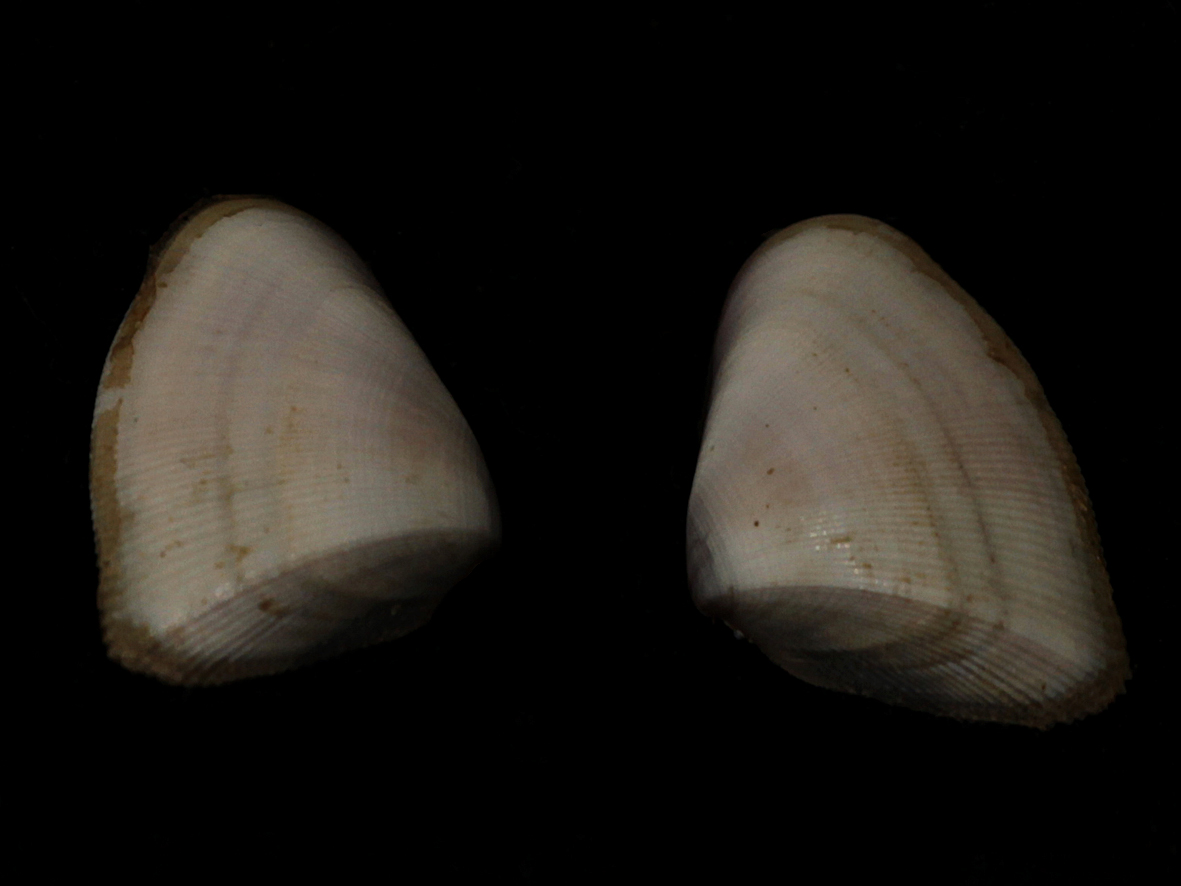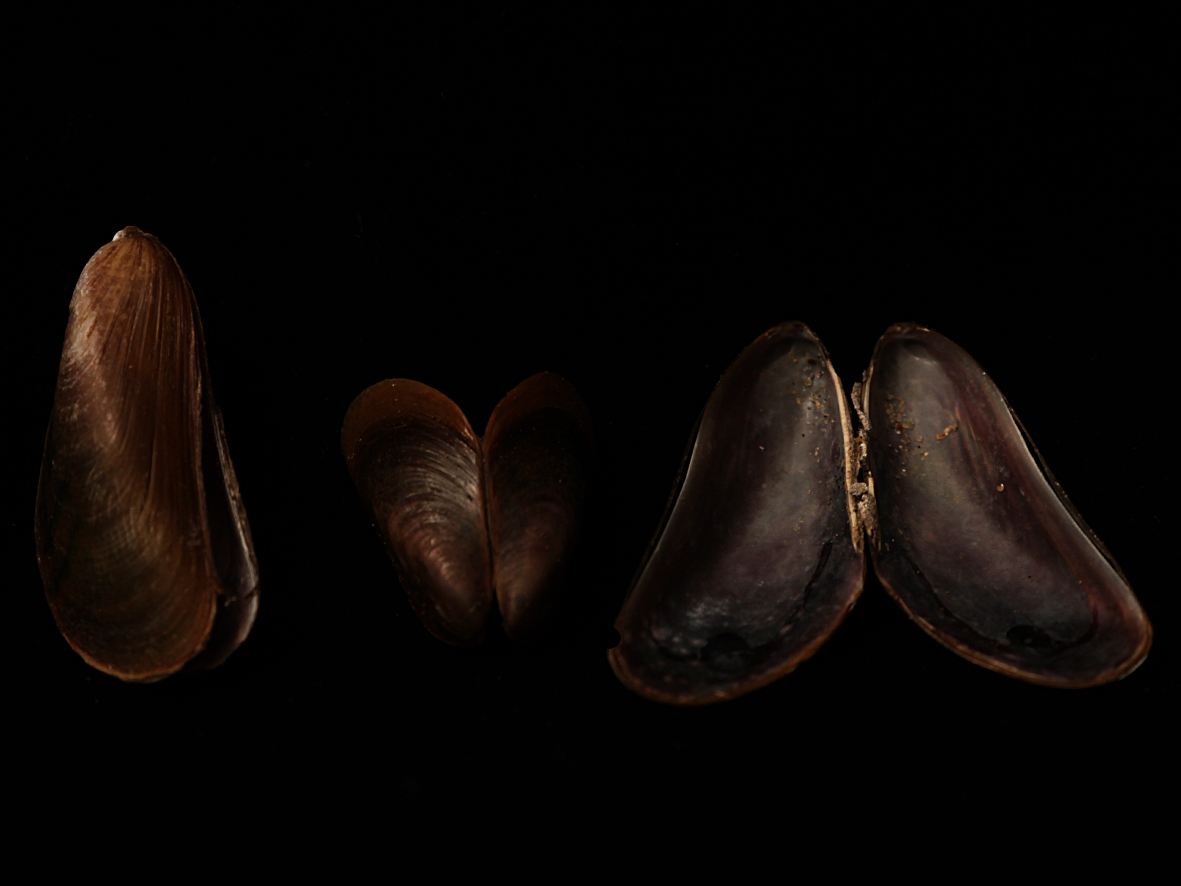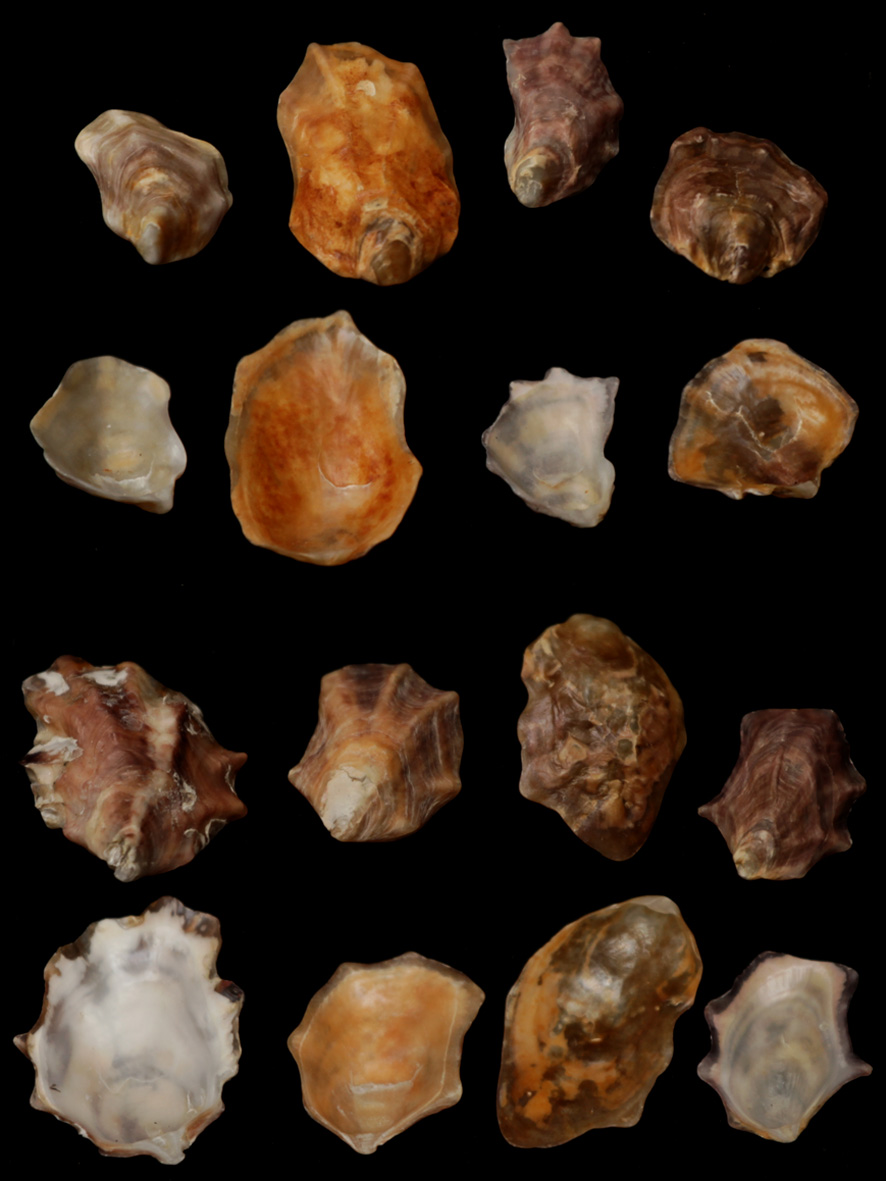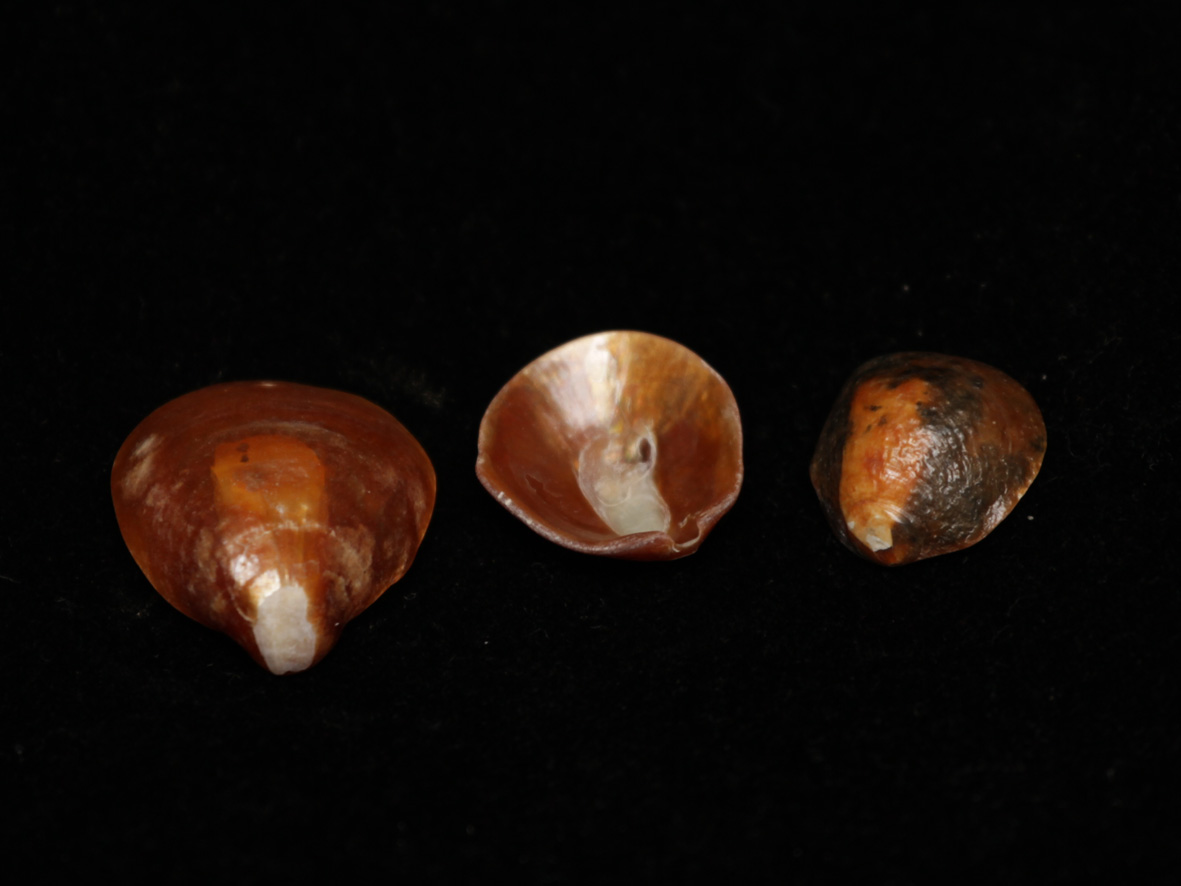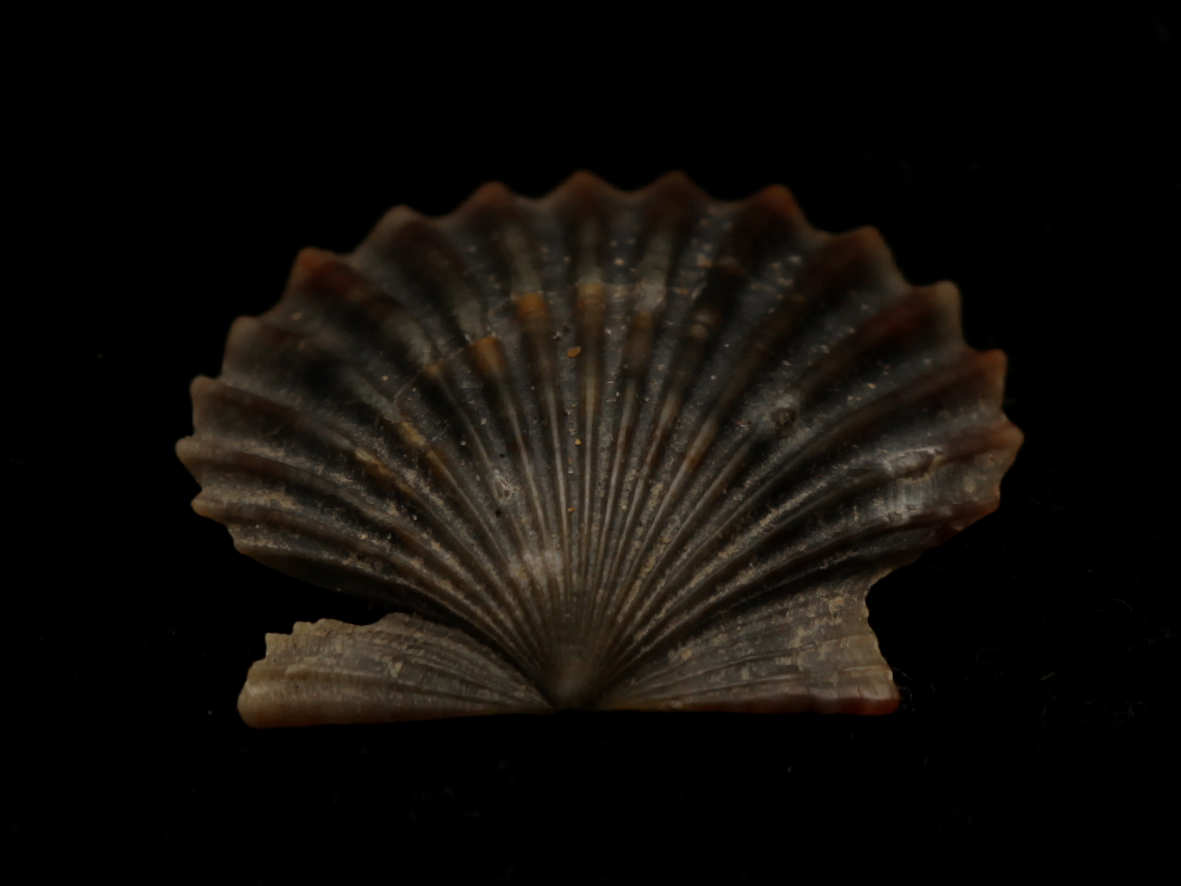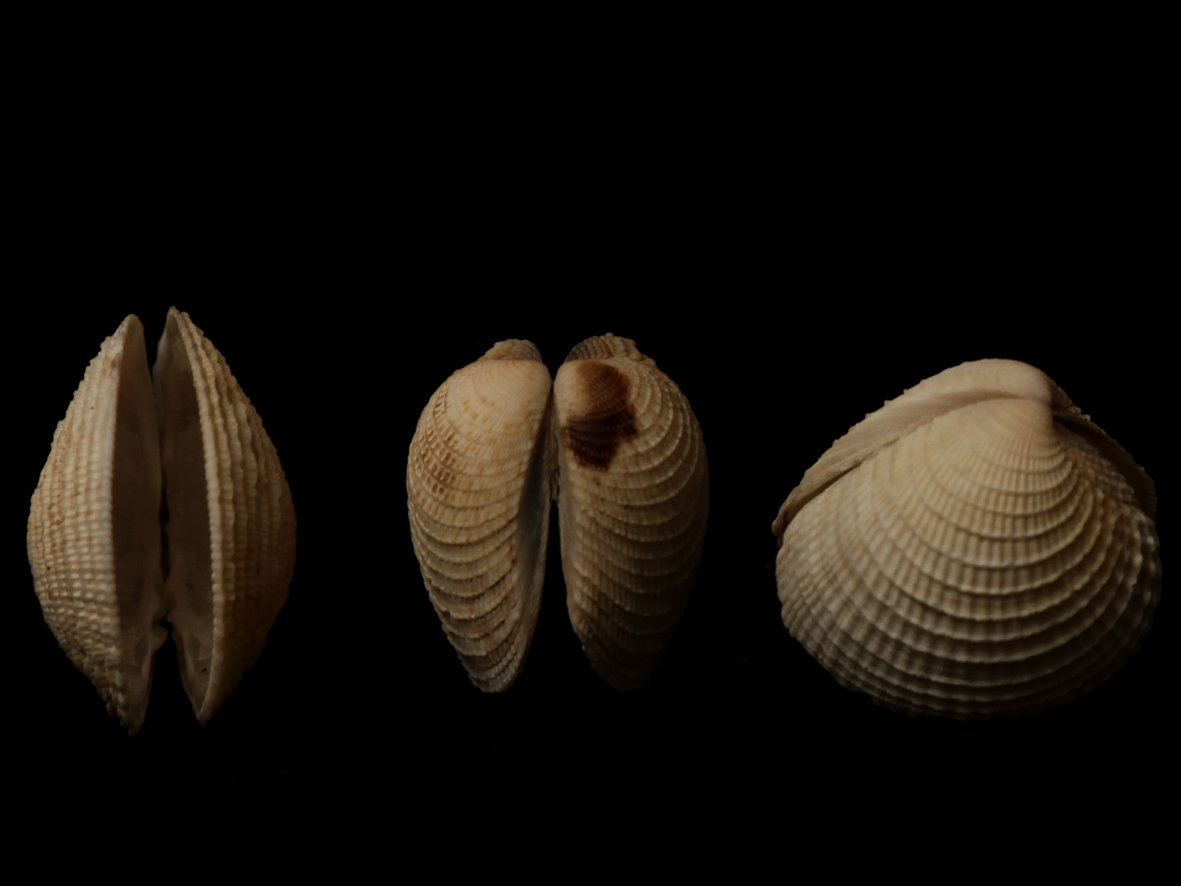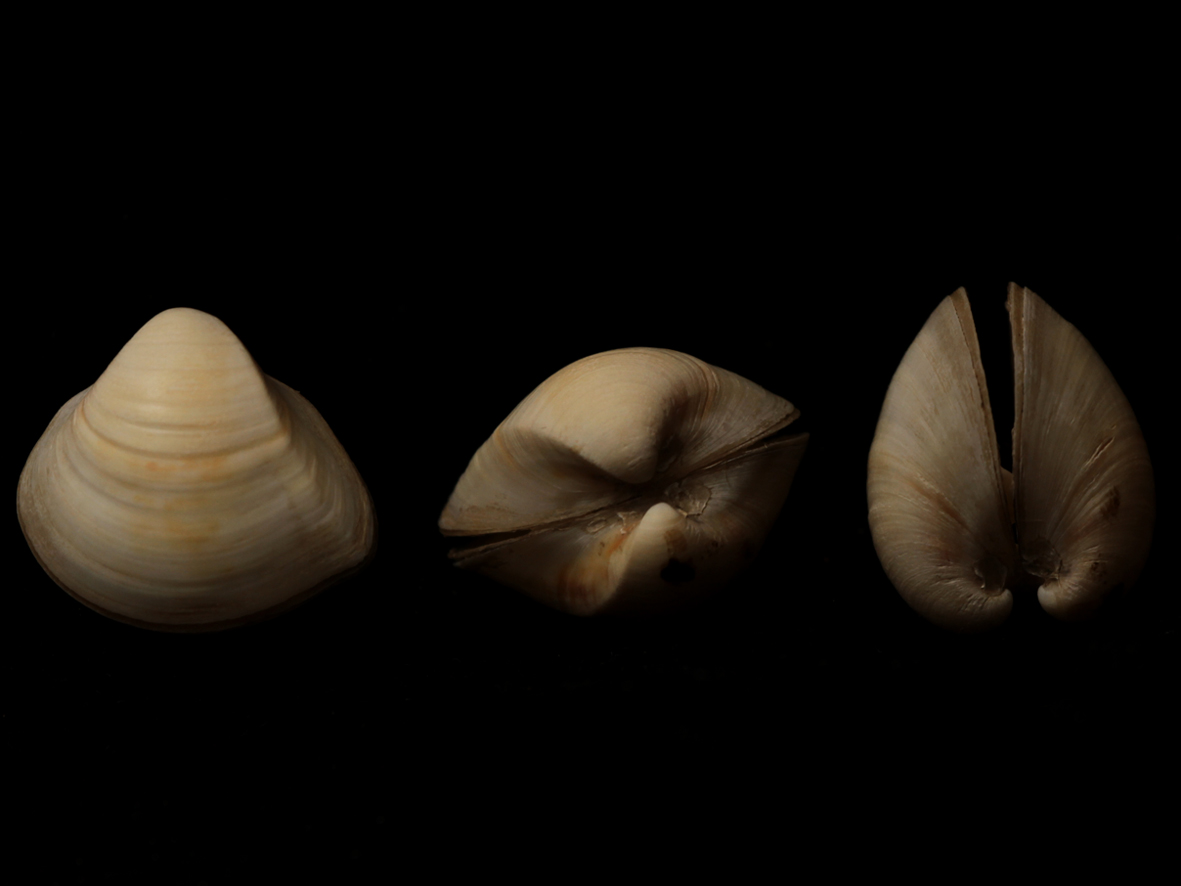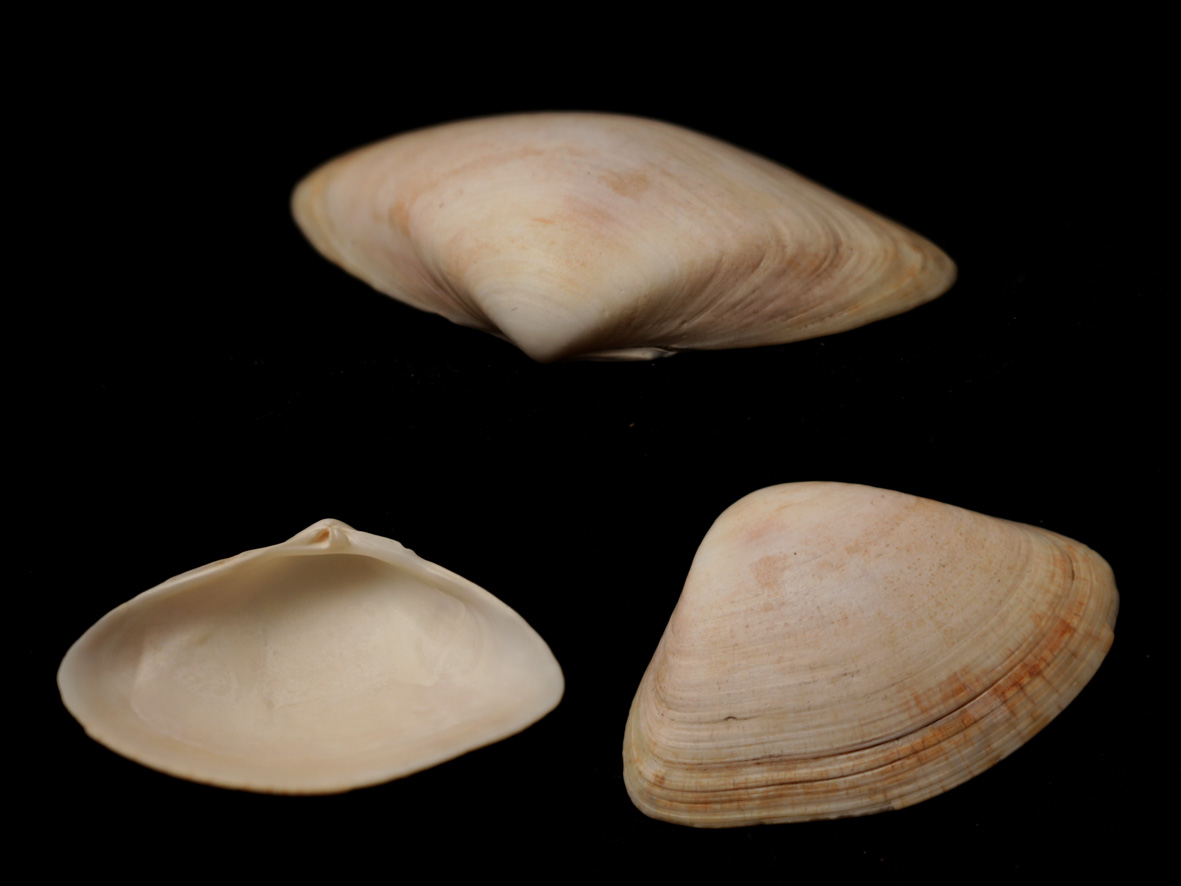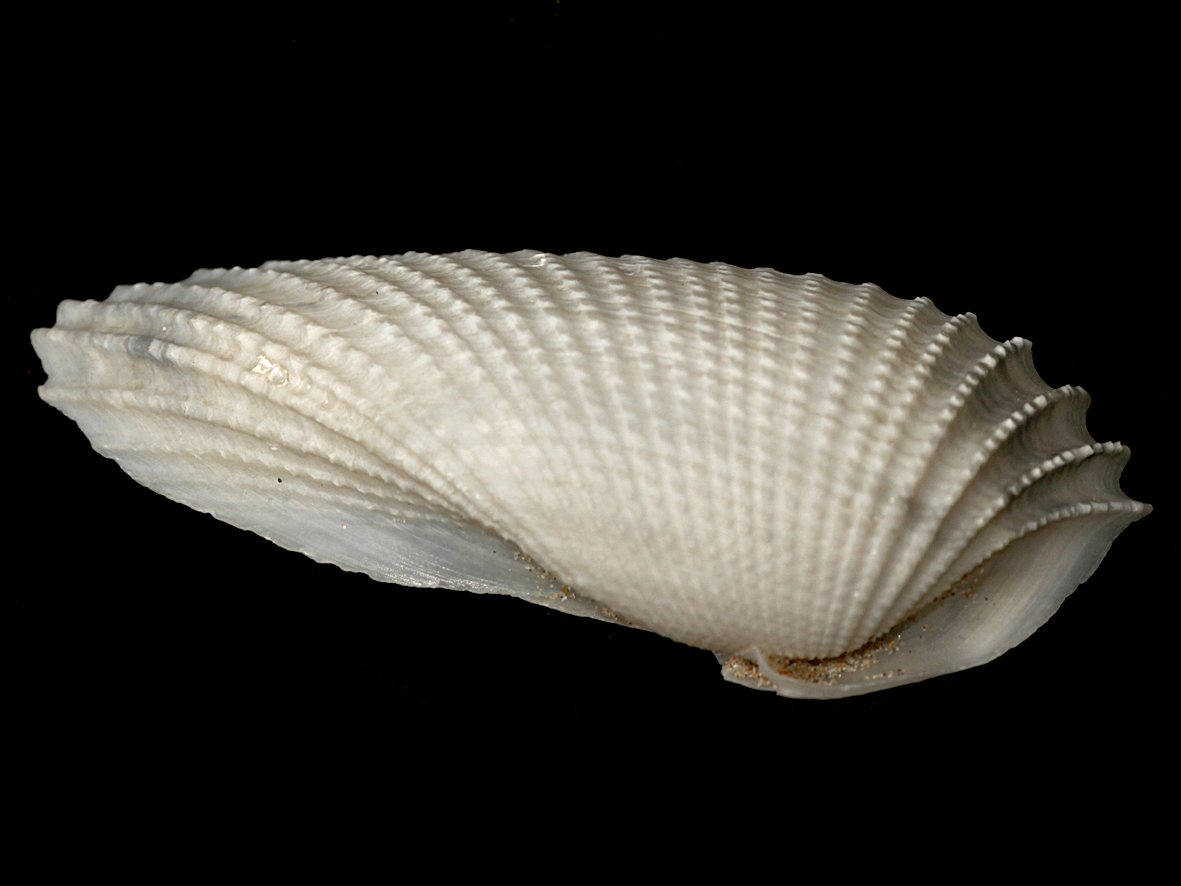Bivalves
The class Bivalvia or Bivalves includes more than 15,000 species of clams, oysters, mussels, and scallops that are characterized by a shell that is divided from front to back into left and right valves. They are called bivalves because the shell exists out of two halves that are mirror images of each other and are joined at one edge by a flexible hinge. Each half is asymmetrical and rounded, so that when it closes against the other half, it forms a domed space near the hinged edge of the shell which accommodates the bulk of the animal’s body and narrows towards the edge of the shell that opens. Some bivalves live on the surface and are relatively sedentary and immobile. They rarely burrow and are thus in permanent contact with relatively clean, mud-free water. (About.com, 2014).
Donax denticulatus (Linneaus, 1758)
Also known as Common Caribbean Donax. The shells are strong, solid, about 2.5 cm in length. The colour is variable—of cream, brown, purple, and grey, with fine radiating brown or purple rays. There may also be concentric rings of white, purple, or brown. There are also numerous fine radiating ribs usually white but sometimes tinted with brown or purple. The apex is usually purple as is the inside of the shell. In the left valve, the anterior cardinal tooth is bifid, but in the right valve it is the posterior one which is bifid. This bifurcation cannot be seen in worn specimens. There are two anterior and two posterior lateral teeth in the right valve, but only one of each in the left valve. The inner margin is crenulated or toothed. The pallial sinus reaches to the midline and is deeper than in D. striatus, from which species it can also be distinguished by the presence of two curved ridges on the posterior slope, D. striatus only having one.
Mytella charruana (d'Orbigny, 1846) (= Mytilus falcatus)
Measuring at up to 7.5 cm long, the Mytella charruana is extremely inequilateral, the beaks found right at the anterior end. It is elongated, rounded on both ends, and resembles a half open fan, the anterior end being pointed and the posterior end broad. Its color is purple, blue, or brown, with a prominent olive, black or yellow-brown periostracum, traces of it usually being seen even in worn specimens. The exterior surface is smooth except for irregular growth rings and the margins are uncrenulated. There are two cardinal teeth in each valve, but in the right one the posterior or lower tooth is bifid the lateral teeth are absent. The ligament is external and bordering this ligament is a row of 100 or more minute teeth (but some are often worn away). The interior of the shell is smooth, purple (whitish in worn specimens) and pearly. This species is fairly common.
Scapharca (=arca) chemnitzii (Phillipi, 1851) - Chemnitzi’s Ark
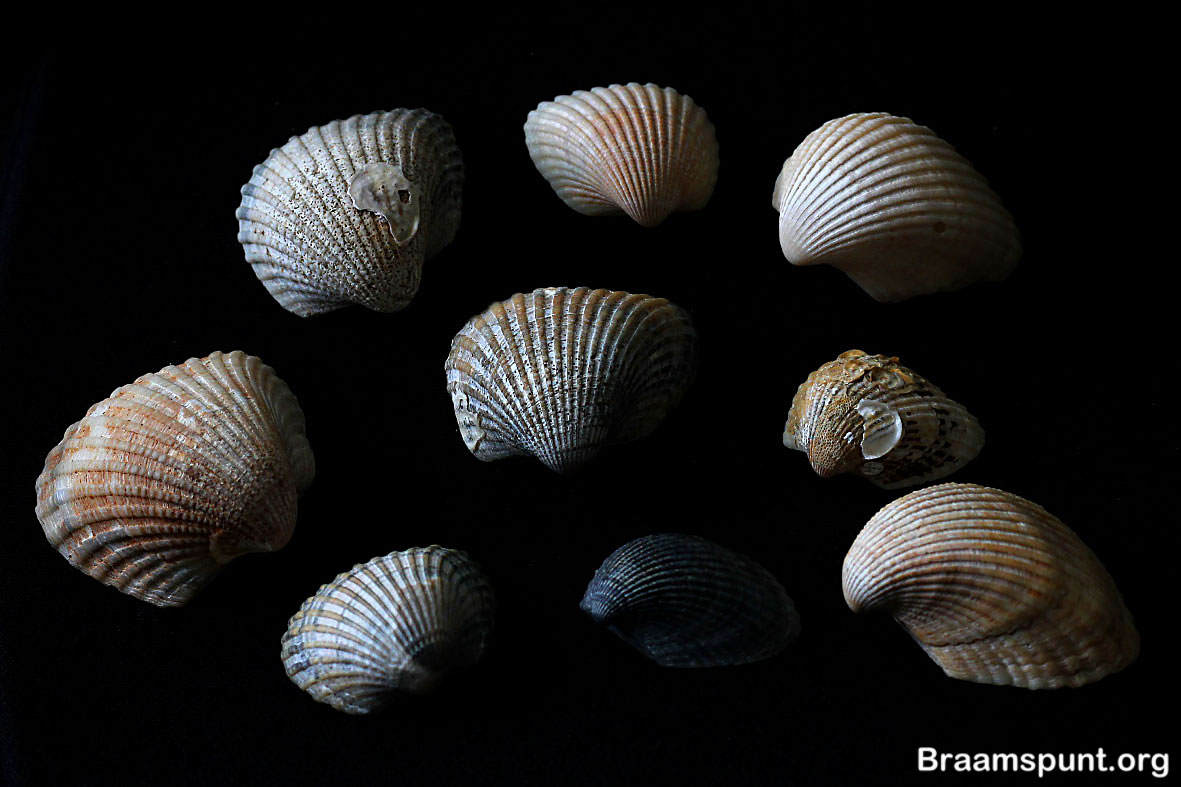 The Scapharca chemnitzii shell is up to 4 cm long and almost just as high. It is thick, sturdy, inflated (convex), equivalve (very slightly inequivalve) and inequilateral (beaks slightly anterior to midline- cf. Sc. Brasiliana which has the beaks more in the middle). It is roughly squarish in shape, the posterior end not so long as in Noetia centrota and Anadara ovalis. It beaks much more widely separated than in the other species (including Sc. Brasiliana), thus exposing a fairly large (and striated) cardinal area. Its color is usually white, but can also be a light brown or grey; banded specimens may occur. Its periostracum is thick, velvety, and reddish-brown in color and often remains in the radial grooves long after death. The surface sculptured by about 28 strong, transversely grooved and beaded (cf. Anadara ovalis) radial ribs. Growth stages are usually prominent. Hinge line with 25-50 teeth the larger specimens usually possessing more. It is fairly common, live specimens often being washed up or found at low tide in the East beach mudflats.
The Scapharca chemnitzii shell is up to 4 cm long and almost just as high. It is thick, sturdy, inflated (convex), equivalve (very slightly inequivalve) and inequilateral (beaks slightly anterior to midline- cf. Sc. Brasiliana which has the beaks more in the middle). It is roughly squarish in shape, the posterior end not so long as in Noetia centrota and Anadara ovalis. It beaks much more widely separated than in the other species (including Sc. Brasiliana), thus exposing a fairly large (and striated) cardinal area. Its color is usually white, but can also be a light brown or grey; banded specimens may occur. Its periostracum is thick, velvety, and reddish-brown in color and often remains in the radial grooves long after death. The surface sculptured by about 28 strong, transversely grooved and beaded (cf. Anadara ovalis) radial ribs. Growth stages are usually prominent. Hinge line with 25-50 teeth the larger specimens usually possessing more. It is fairly common, live specimens often being washed up or found at low tide in the East beach mudflats.
Noetia (=Arca) centrota (Guppy, 1867) (= martini)
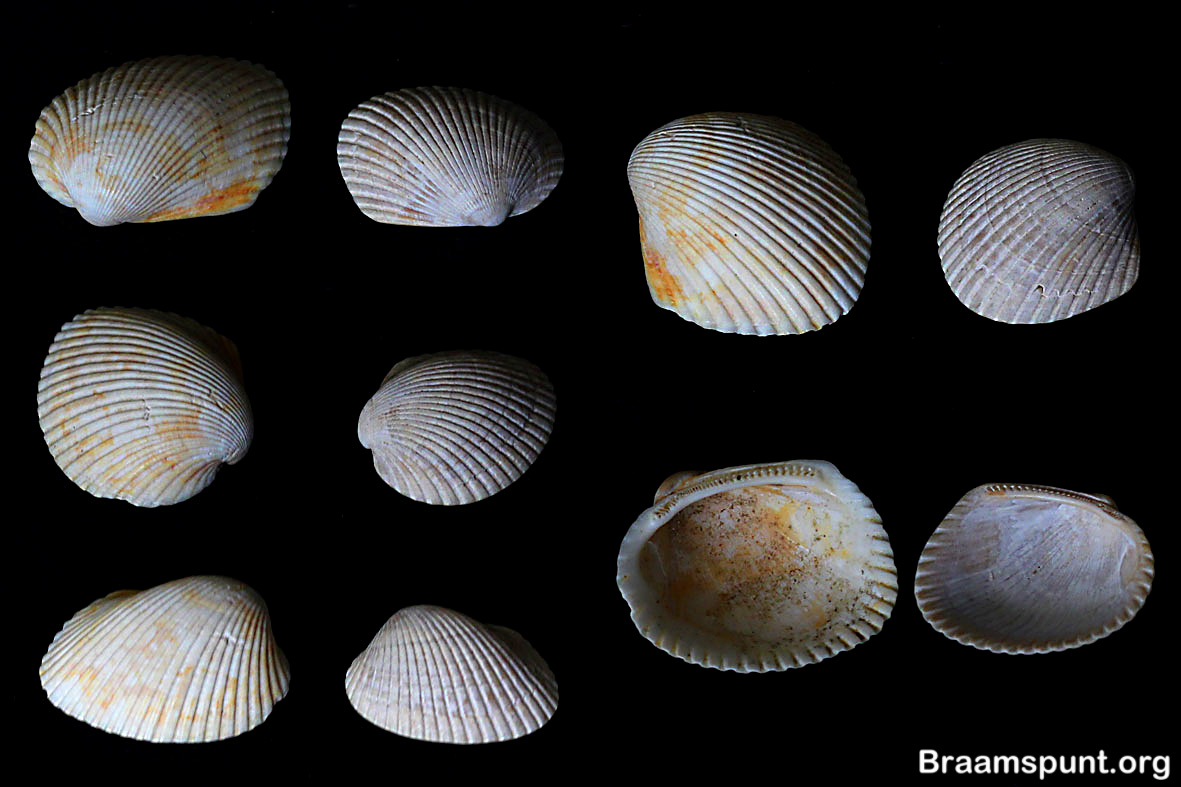
The Noetia Centrota is up to 4 cm in length. It is equivalve, inequilateral (it beaks in anterior half), thick, oblong in shape, rounded anteriorly and elongated posteriorly. The posterior end is much longer than in the other species and bears two radial ridges (which can be seen slightly indented, thus assuming on ear-like appearance). The beaks are fairly close together. It is white, light brown, or grey in color and is sometimes banded. The Interior of shell is whitish (but usually depends on the external coloring). It is sculptured by 32-35 finely beaded ribs (cf. Andara ovalis) with smaller riblets (also finely beaded) in the grooves between them (one per groove). Heavily marked growth rings can be seen in some specimens of this species. It has 28-36 hinge teeth, the larger specimens usually having more. The periostracum is thick, hairy, and reddish brown in color. This shell is not quite as common as the other two species.
Crassostrea lacerta Hanley
The Crassostrea lacerta is a fairly thin shell, measuring up to 5 cm long. It is equivalve, inequilateral, and varies in shape from being long and narrow to being broadly circular, thus being highly irregular and often distorted. It often grows attached to each other in colonies which increases this irregularity and distortion. The color of the shell is usually a purplish-brown, but older more worn out and faded specimens may be a light brown. One shell found was black and in some places had worn away to reveal the yellow-brown undercoat, thus appearing mottled. The interior of shell is smooth and glossy. There are 5-8 weak radial ribs (often inconspicuous) and the ventral margin between these ribs is greatly indented, thus resembling a duck’s foot. These ribs and the indentations in the ventral margin are not so obvious in the long narrow forms. The ribs may bear nodules along their lengths. There is a prominent chondrophore. Single valves were very common and colonies, sometimes living, were commonly found cemented to Tonna, Pugilina, and many other shells.
Anomia simplex (d’Orbigny, 1842) - Common Saddle Oyster or Jingle Shell
Measuring up to 5 cm in length, the Anomia simplex is known to show varying degrees of distortion depending on its situation. Its color is usually black due to being in mud, but sometimes grey or light brown valves may also be found. In the Caribbean this species is a translucent yellow, silver, or orange. The surface is usually smooth and shiny apart from concentric growth rings. The inside of the shell is black and smooth (velvety to touch) and the left valve bears three muscle scars (one large adductor scar and two small byssal ones). The right valve bears only the single scar of the furrow. The hinge line may bear small crenulations. The margins are smooth. Usually only the upper (left) valve is washed ashore and is larger and more convex than the lower one which is smaller, flatter and also bears the byssal hole near the apex. It is found along the whole of the Atlantic coast.
Chlamys linky (Dall, 1926)
The Chlamys linky is inequivalve, inquilateral (beaks slightly anterior to midline), and measures up to 3 cm long. Its coloring is white, cream, yellow-brown, orange-brown, red-brown or black, flecked with creams, browns, purples and greys. The upper (left) valve is slightly more convex than the lower one, and lacks the byssal notch; 14-16 strong, radial ribs sculpture each valve. The ears are also less prominent; the ears are sculptured by 14-16 strong, radial ribs. The ears are ribbed and roughly equal in length although in many specimens the posterior ear is often worn thus looking much shorter than the anterior one. The presence of the byssal notch (which is toothed or serrated) also makes the anterior ear look longer. Chondrophore is prominent.
Chlamys gibba nucleus . Born-Calico Scallop.
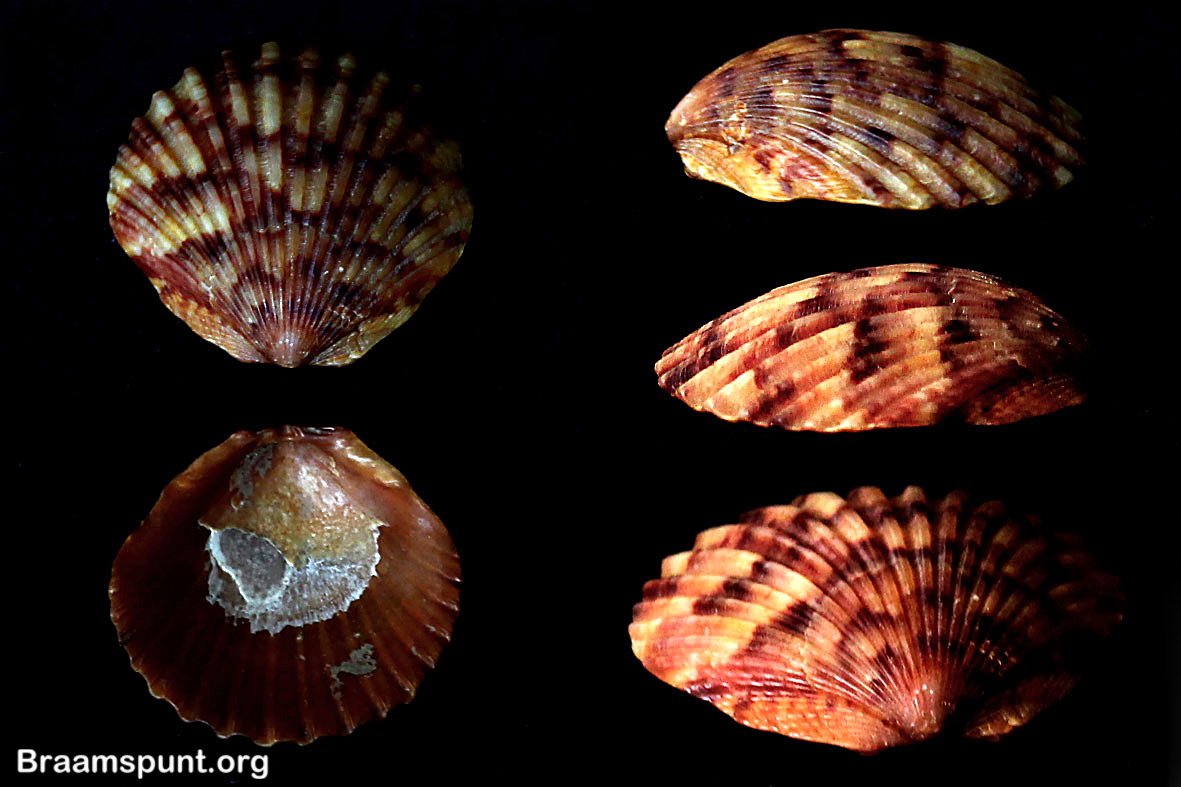
This species is easily distinguished from C. linki because both valves are much more convex, it is much stronger and thicker, bears more ribs, and are usually larger. It is slightly inequivalve, equilateral, and is up to 2in. in length. The shell itself is grey or white in color and is often splashed with grey-black, purple, crimson, orange and brown. Each valve is sculptured by 20-28 ribs that are broader, flatter, and closer together than in C. linki. The whole surface bears very fine concentric laminations or striae, which in worn specimens can only be seen in the grooves between the ribs. The ears are again sculptured, but are much less prominent than in C. linki as is the byssal notch. There are 2 ridges (for articulation) on either side of the prominent chondrophore. This species is uncommon. The valves tend to be very worn and often broken.
Crassostrea guyanensis Ranson
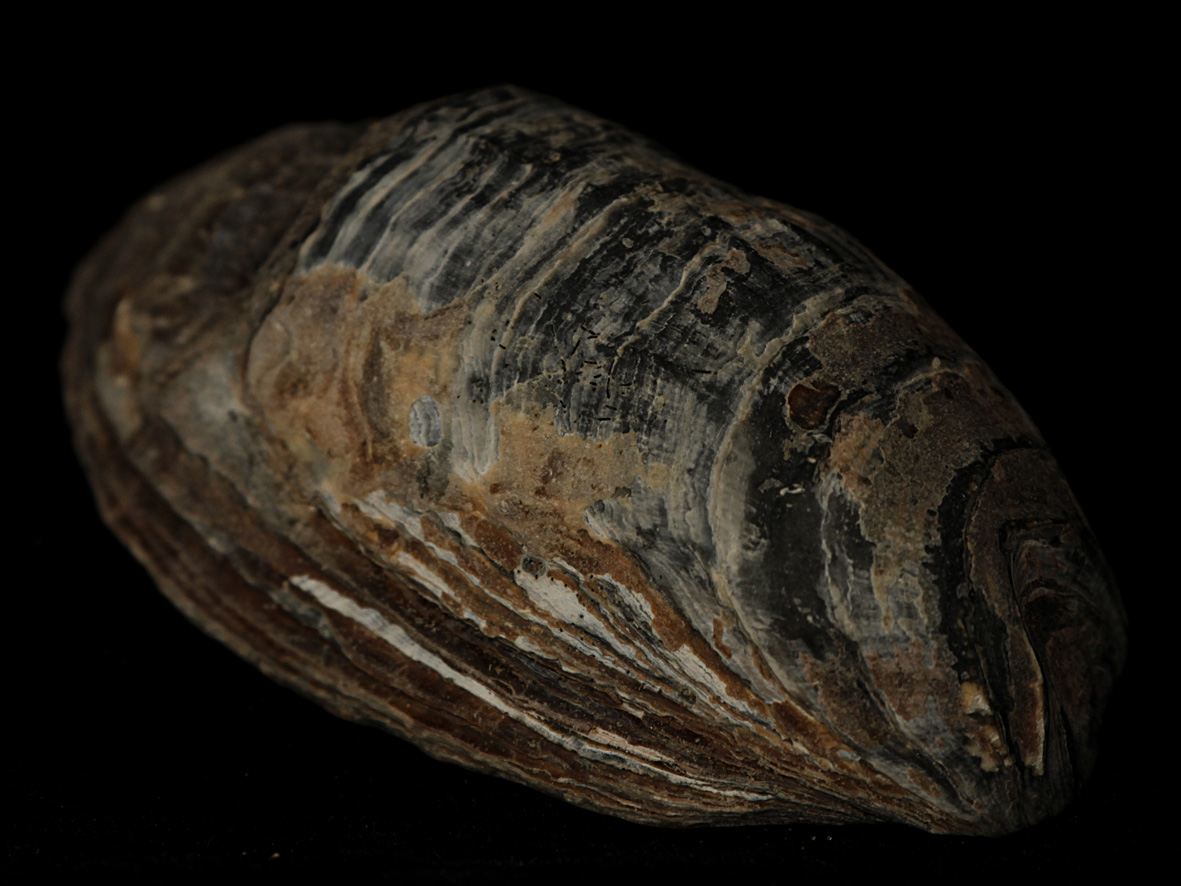 The Crassostrea guyanensis is easily distinguishable from the Crassostrea lacerta, seeing as it is larger, thicker, stronger, and heavier. It measures up to 15 cm long, is usually circular in shape, and inequivalve. The lower or left valve being larger and deeper than the upper (right) one that often only acts as a lid. The surface is usually rough and highly irregular with pits, cavities, ridges and growth rings, but is sometimes worn smooth apart from the growth rings. It is dark grey in color and is often tinted with purple, while worn specimens are lighter in color like a yellow cream but still tinted with purple. The interior of shell is a dirty white or grey and is usually smooth and glossy. The beaks, although inconspicuous, can be distinguished by the chondrophore and also by the concentric growth rings that start and finish there. The single muscle scar is large and distinct and often tinted with pink or purple, but this tinting can really only be seen in specimens with a white interior. The shell margins smooth. This species is uncommon as well as edible.
The Crassostrea guyanensis is easily distinguishable from the Crassostrea lacerta, seeing as it is larger, thicker, stronger, and heavier. It measures up to 15 cm long, is usually circular in shape, and inequivalve. The lower or left valve being larger and deeper than the upper (right) one that often only acts as a lid. The surface is usually rough and highly irregular with pits, cavities, ridges and growth rings, but is sometimes worn smooth apart from the growth rings. It is dark grey in color and is often tinted with purple, while worn specimens are lighter in color like a yellow cream but still tinted with purple. The interior of shell is a dirty white or grey and is usually smooth and glossy. The beaks, although inconspicuous, can be distinguished by the chondrophore and also by the concentric growth rings that start and finish there. The single muscle scar is large and distinct and often tinted with pink or purple, but this tinting can really only be seen in specimens with a white interior. The shell margins smooth. This species is uncommon as well as edible.
Protothaca pectorina (Lamarck, 1818)
The Protothaca pectorina species is similar to the Chione subrostata but is usually thicker and larger, growing up to 5 cm. The radial ribs are much stronger and more distinct, but the concentric ridges, although present, are faint, the emphasis in sculpture thus being on the radial ribs. Thus when stroked radially, the Chione feels rough but the Protothaca feels smooth. Its color varies from buff-brown to slate grey, and often bears alternating light and dark bands concentrically arranged. The lunule, is still bordered by a chocolate-brown as in C. subrostrata. The inner margin is again crenulated, but the posterior slope is more curved and less steep than in C. subrostrata when viewed from the inside. There are 2 cardinal teeth and one anterior lateral in each valve, the anterior cardinal being bifid on the left valve (but single in the right valve) and the posterior being bifid in the right valve and single in the left one ( as in C. subrostrata). The Pallial sinus is fairly well developed.
Chione subrostrata (Lamarck, 1818)
Measuring up to 4 cm long, the Chione subrostrata is inequilateral (beaks anterior to midline). They are usually a uniform white or creamy buff color, with radial or zigzag chocolate-brown markings and pink tinted beaks; slate grey specimens are also common. The sculpturing consists of many fine radial ribs traversed by graceful concentric ridges thus giving a cancellate appearance. In all except the slate grey forms, the lunule is chocolate-brown in color and bordered by a small groove. The escutcheon bears chocolate-brown markings even in otherwise unmarked specimens. The inner and ventral margins are crenulated due to the termination of the radial ribs. There are three hinge teeth in each valve (two cardinals and one anterior lateral). In the left valve the anterior cardinal tooth is bifid, but in the right valve the posterior one is bifid. The pallial sinus is obvious but not greatly developed. It is very common, specimens often being washed up alive at Braamspunt.
Dosinia Concentrica (Born, 1778) - Southern Dosinia
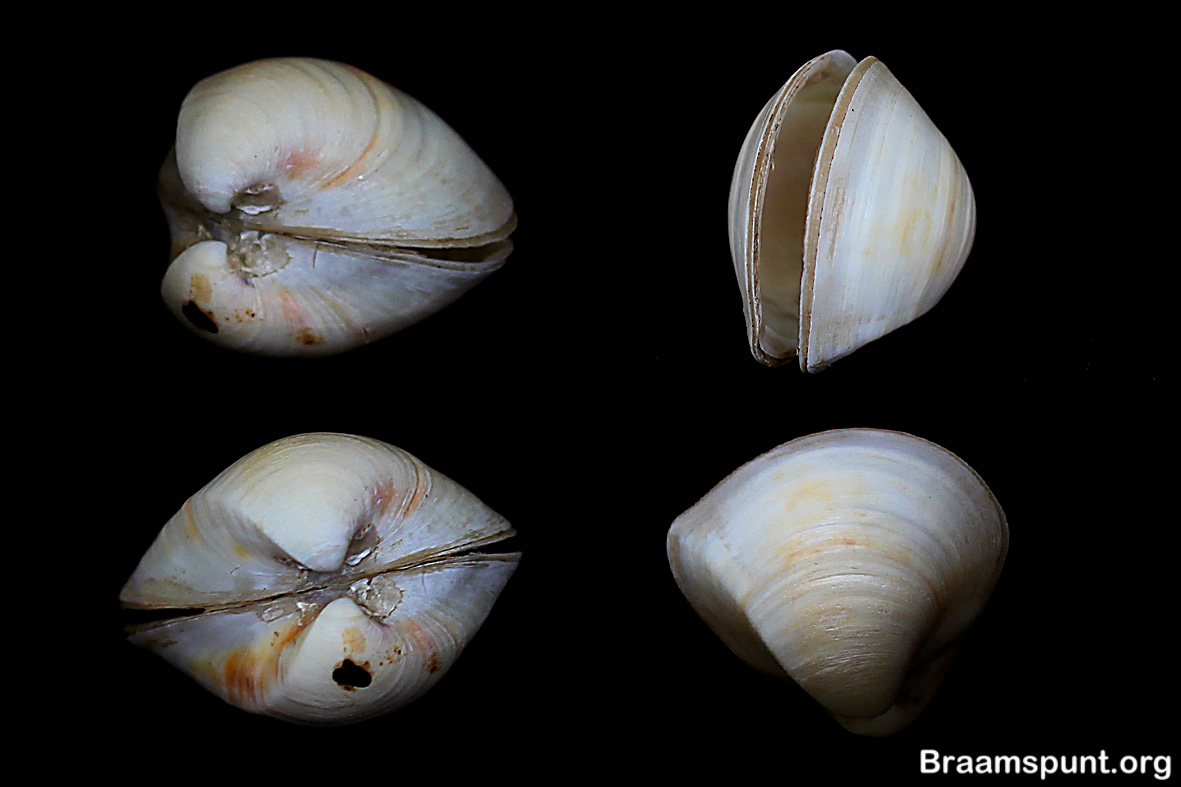
This species measures up to 7.5 cm long; it is sturdy, inequilateral (beaks prominent, pointed and anterior to midline), and broadly circular in shape. It has a glossy yellowish-white color and is sculptured with many low, smooth, neat and even, concentric ribs or ridges which become closer together in the umbonal region, and closer together and more prominent in the posterior region. In a specimen about 4.5 cm high there were twelve of these ribs in the first cm, and eleven in the first cm from the ventral margin inwards along the midline. In some old specimens, the ribs had been worn away and the shell was a chalky white or grey color. Growth rings are visible, but there is no axial sculpture and can thus be easily distinguished from the other Veneridas. The inside of the shell is smooth and white. There are three cardinal teeth in each valve, but in the right one the posterior is grooved along its length thus appearing double. The margins are smooth but in the region of the lunule there is a characteristic indentation. The pallial sinus is fairly well developed.
Macoma constricta (Bruguiere, 1792) - Constricted Macoma
Measuring up to 7.5 cm long, the Macoma constricta is thin, but fairly strong, as well as fairly inflated. It is white or grey in color with a thin, fawnish-grey periostracum. The interior of the shell is smooth and the same color as the rest of the shell. It is pointed and partially truncate posteriorly. There is a kink or indentation in the posterior ventral margin, which in most specimens can be traced radially across the surface to the beaks. This kink is bordered by two ridges or folds, which may also be traced radially to the beaks. Surface sculptured by numerous growth lines and extremely fine radial rays, but is nevertheless still fairly smooth. There are two cardinal teeth in each valve. Lateral teeth are absent (as in all species of Macoma). Pallial sinus very well developed reaching almost to the anterior muscle scar and is confluent along most of its length with the pallial line. The anterior adductor muscle scar is slightly thinner and longer than the posterior one (cf. Strigilla gabbi).
Tellina diantha (Boss, 1964)
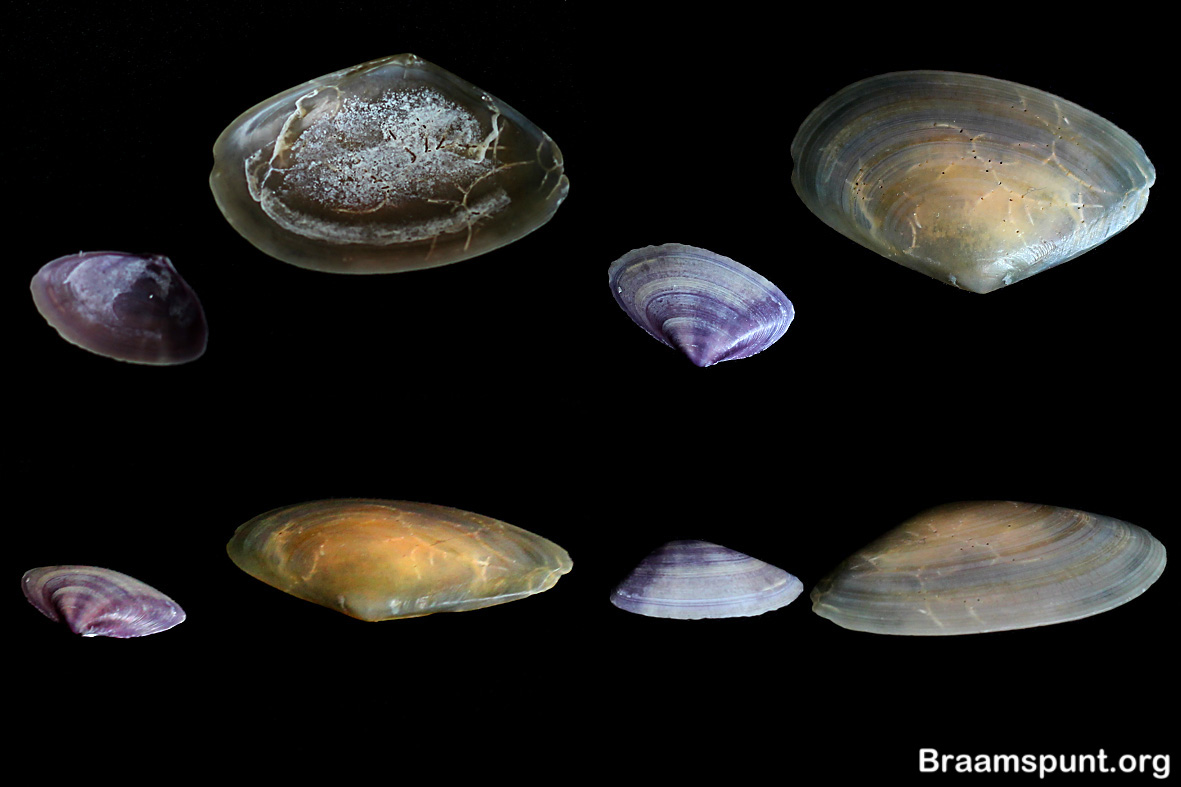
The Tellina diantha is small brittle shell, measuring up to just over ½in. Its color is pink or pinkish-orange with a brown periostracum. The surface smooth and polished, with many fine concentric growth lines. The interior of shell is smooth, polished, and is the same color as exterior. Its posterior radial ridge present is close to the dorsal margin. The right valve bears 2 cardinal teeth (1 anterior and 1 posterior lateral). The left valve bears 2 cardinal teeth and 1 posterior lateral, but there is no anterior lateral. The lateral teeth are weak and only appear as raised or thickened portions of the dorsal margin. The pallial sinus is well developed, reaching past the midline but falling short of the anterior adductor muscle scar. Confluent is found along its length with the pallial line. Anterior adductor muscle scar is slightly thinner and longer than the posterior one. It differs from the small specimens of Tellina trinitatis in that the pallial sinus is further away from the dorsal margin. This species is extremely rare.
Iphigenia brasiliensis (Lamarck, 1818) – Giant False Donax
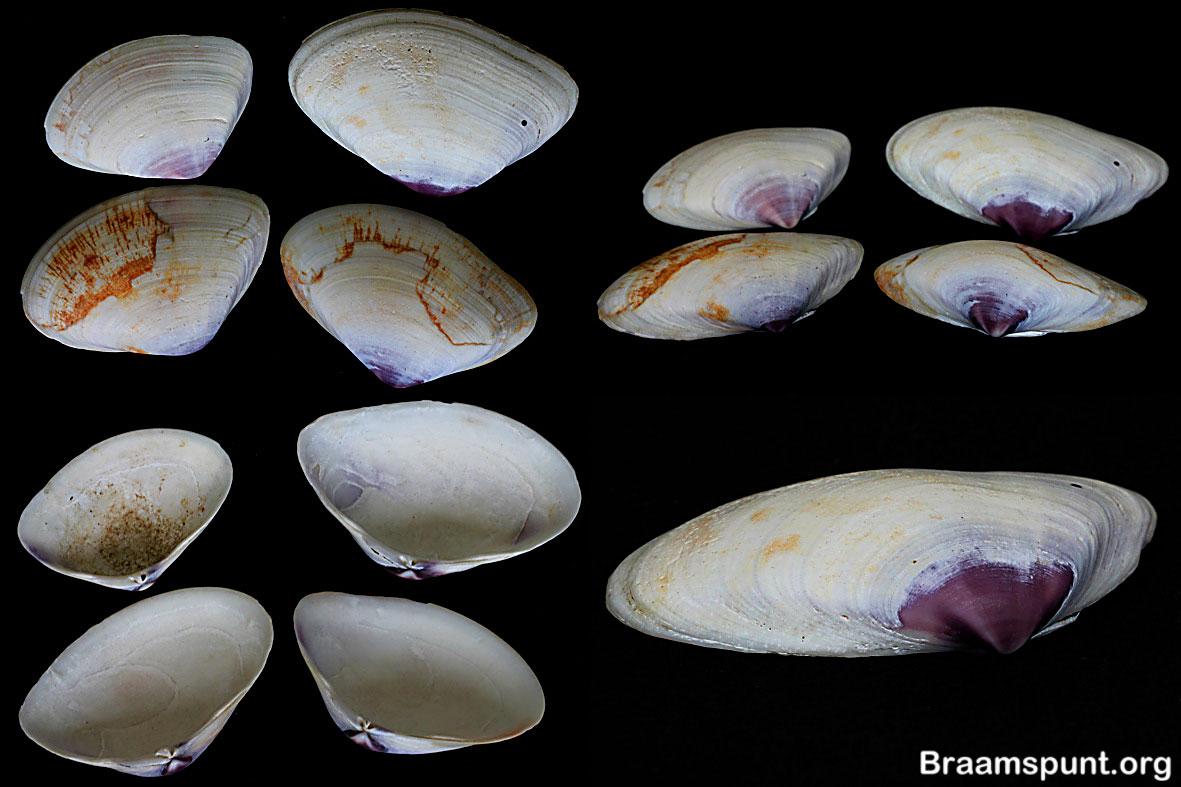 The Iphigenia brasiliensisis very similar in shape and color to the D. denticulatus specimen, but is much thicker and larger, growing up to 7.5 cm. It has prominent beaks that are usually tinged with purple. The inside of the shell varies from buff to dark grey depending on the color of the outside of the shell. The lateral teeth are absent. In the left valve the anterior one is bifid but in the right valve the posterior one is, in worn specimens this bifurcation cannot usually be seen. At the posterior end there is a slight indentation in the ventral margin. The surface is smooth except for irregular growth lines, and the inner margin is not crenulated or toothed. The pallial sinus is very large and stretches past the midline. The periostracum is thin and brown. It lives in shallow or brackish water and is fairly common.
The Iphigenia brasiliensisis very similar in shape and color to the D. denticulatus specimen, but is much thicker and larger, growing up to 7.5 cm. It has prominent beaks that are usually tinged with purple. The inside of the shell varies from buff to dark grey depending on the color of the outside of the shell. The lateral teeth are absent. In the left valve the anterior one is bifid but in the right valve the posterior one is, in worn specimens this bifurcation cannot usually be seen. At the posterior end there is a slight indentation in the ventral margin. The surface is smooth except for irregular growth lines, and the inner margin is not crenulated or toothed. The pallial sinus is very large and stretches past the midline. The periostracum is thin and brown. It lives in shallow or brackish water and is fairly common.
Corbula caribaea (d’Orbigny, 1842) (= C. swiftiana C.B Adams) – Caribbean Corbula or Swift’s Basket Shell.
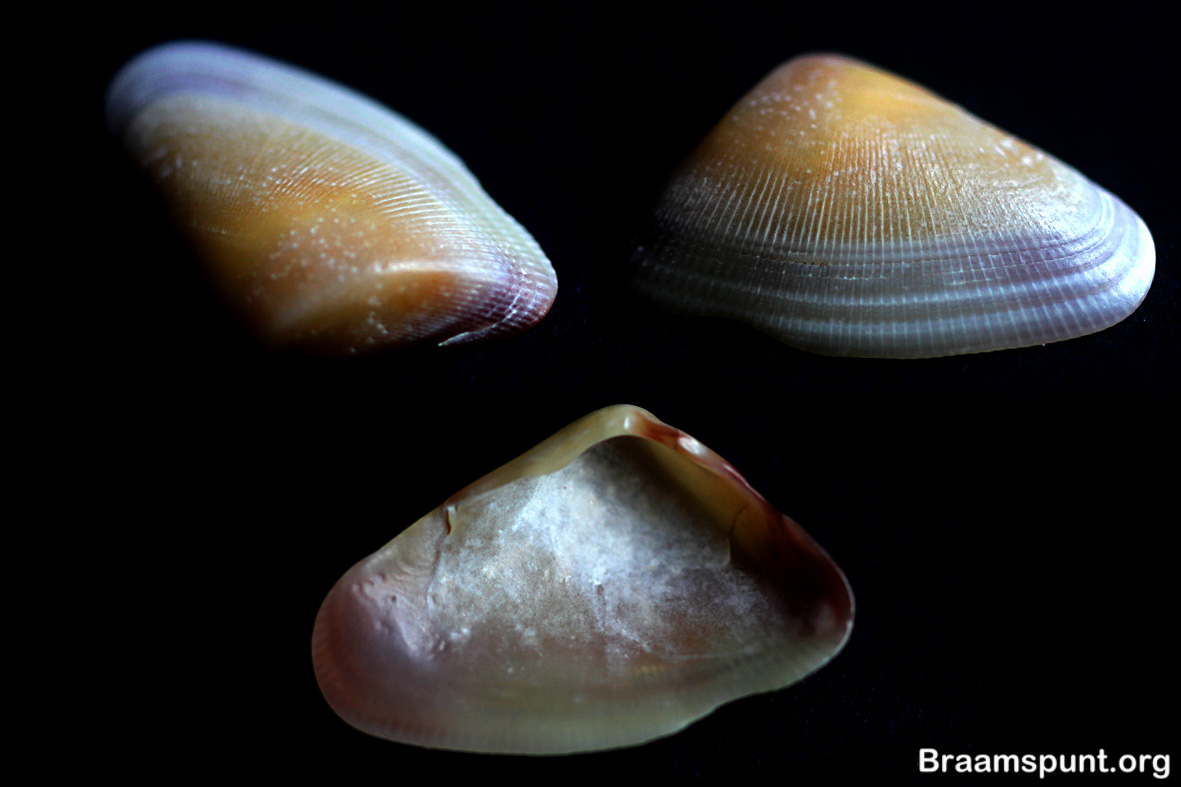
The Cobula caribaea shell species measures up to 1.5 cm, and is thick, sturdy, very convex, almost equilateral (beaks very slightly anterior to midline) and inequivalve. It is rounded anteriorly but varies considerably in shape posteriorly from being partially truncate to being drawn out into a fairly sharp point. Also, the beaks in some specimens may not be nearly so convex and overhanging the dorsal margin as in others. Its color is a dull white, cream, whitish-grey or grey color with a yellowish periostracum. Strong, smooth, distinct, irregular concentric ribs or ridges sculpture the surface. The interior of shell is dull and white or grey, depending on the external color. Ligament internal in chondrophore. The right valve bears two posterior radial ridges, but the second one is very close to the dorsal margin and may be difficult to see. The left valve has only a single ridge. The right valve bears a single projecting cardinal tooth which fits into a V-shape socket in the left valve in such a way that it looks as if part of the hinge line in the left valve has been cut away. The left valve has only a very small projecting cardinal tooth. The adductor muscle scars roughly equal in the size, the posterior one being on a slightly raised platform.
Cyrtopleura costata (Linnaeus, 1758) – Angel wing
The Cyrtopleura costata can attain lengths of up to 20 cm, but at Braamspunt there were some found that were only 10 cm. Its color varies from white to slate grey. The interior of the shell is furrowed due to the external ribs, the periostracum thin and grayish Valves bear 24-27 strong beaded ribs, which are especially sharp and abrasive anteriorly. The hinge extends dorsally into a large unseptated umbonal reflection. Under the beaks there is a spoon-shaped apophysis, but which is often missing in specimens washed up on the beach. Margins crenulate. They live one foot under the surface.
Mactrellona iheringi (Dall, 1897)
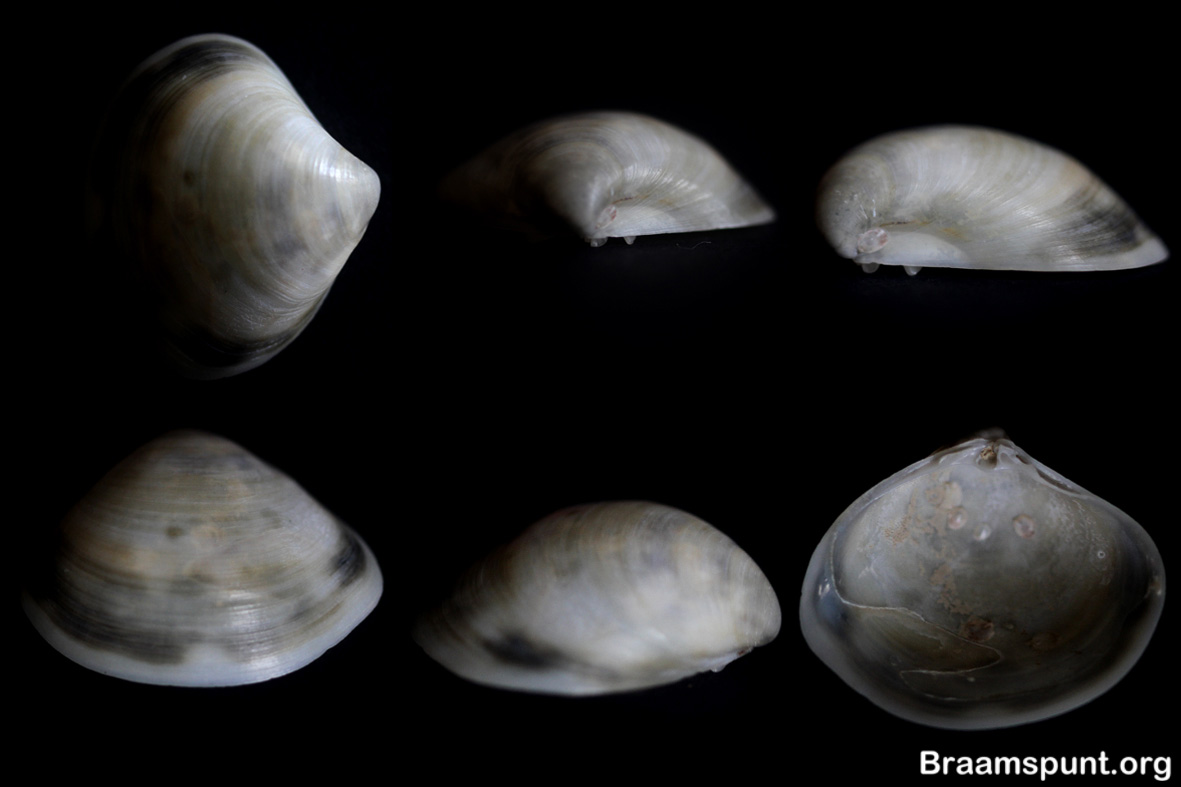 Reaching up to 5.5 cm long, the Mactrellona iheringi species are inequilateral (their beaks prominent, pointed and anterior to midline), with slightly more pointed anteriorly. The shell itself is thin, fragile and smooth except for fine concentric growth rings that become rougher both anteriorly and posteriorly. They are a white, grey, yellow-brown, or cream in color and the interior is the same color as the exterior. They are known to lack the posterior radial ridge of the Mulinia cleryana, Mactra petitii and Mactra surinamensis shells. The left valve bears one anterior lateral, one posterior lateral and three cardinal teeth, two of the latter teeth forming the characteristic V-shape. The third cardinal tooth is weak and sometimes broken. The right valve bears two cardinals, two anterior and two posterior laterals. The ligament is both external and internal: the chondrophore (containing the internal portion) being is set off from the rest of the ligament by a thin plate or septum. The pallial sinus is fairly well developed and stretches to the midline. Single valves are common but double valves are more rare.
Reaching up to 5.5 cm long, the Mactrellona iheringi species are inequilateral (their beaks prominent, pointed and anterior to midline), with slightly more pointed anteriorly. The shell itself is thin, fragile and smooth except for fine concentric growth rings that become rougher both anteriorly and posteriorly. They are a white, grey, yellow-brown, or cream in color and the interior is the same color as the exterior. They are known to lack the posterior radial ridge of the Mulinia cleryana, Mactra petitii and Mactra surinamensis shells. The left valve bears one anterior lateral, one posterior lateral and three cardinal teeth, two of the latter teeth forming the characteristic V-shape. The third cardinal tooth is weak and sometimes broken. The right valve bears two cardinals, two anterior and two posterior laterals. The ligament is both external and internal: the chondrophore (containing the internal portion) being is set off from the rest of the ligament by a thin plate or septum. The pallial sinus is fairly well developed and stretches to the midline. Single valves are common but double valves are more rare.
Martesia striata (Linnaeus, 1758) - Wood Piddock
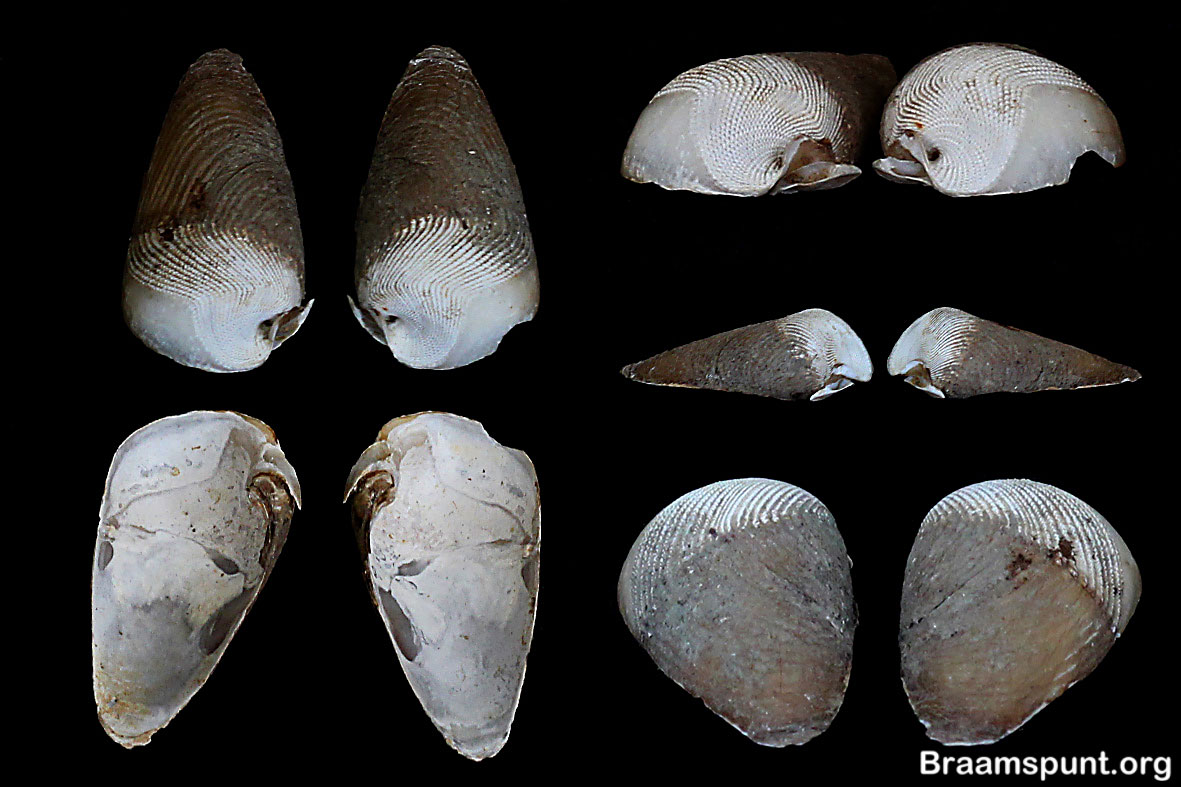 Measuring at up to 4 cm in length, the Martesia striata are white in color with a thin fawn periostracum. The interior of the shell is white and smooth, except for the radial groove, which shows through as a small ridge. They have beaks nearly at anterior end, and at the anterior end the valves are short, rounded and almost closed but taper and elongate posteriorly to a rounded point where the gape is wider. The posterior end is also very fragile and easily broken. There is a fine radial groove from the beaks to the ventral margin and anterior to this groove and there are numerous finely denticulated ribs. Posterior to this groove there are concentric growth rings. On both the dorsal and ventral surfaces there is a long narrow calcareous plate between the valves, which probably serves to keep them together. In addition there is a characteristic circular shield or plate over the beaks. The umbonal reflection is small and the apophysis long and thin. The ligament is very small. Pallial sinus reaches past the internal ridge. Margins smooth. They bore into driftwood (usually against the grain) and are not so uncommon. When seen along the beach, they are found in great numbers (i.e. colonies).
Measuring at up to 4 cm in length, the Martesia striata are white in color with a thin fawn periostracum. The interior of the shell is white and smooth, except for the radial groove, which shows through as a small ridge. They have beaks nearly at anterior end, and at the anterior end the valves are short, rounded and almost closed but taper and elongate posteriorly to a rounded point where the gape is wider. The posterior end is also very fragile and easily broken. There is a fine radial groove from the beaks to the ventral margin and anterior to this groove and there are numerous finely denticulated ribs. Posterior to this groove there are concentric growth rings. On both the dorsal and ventral surfaces there is a long narrow calcareous plate between the valves, which probably serves to keep them together. In addition there is a characteristic circular shield or plate over the beaks. The umbonal reflection is small and the apophysis long and thin. The ligament is very small. Pallial sinus reaches past the internal ridge. Margins smooth. They bore into driftwood (usually against the grain) and are not so uncommon. When seen along the beach, they are found in great numbers (i.e. colonies).
Anadara ovalis (Bruguiere, 1789) (= Arca campechiensis) – Blood ark
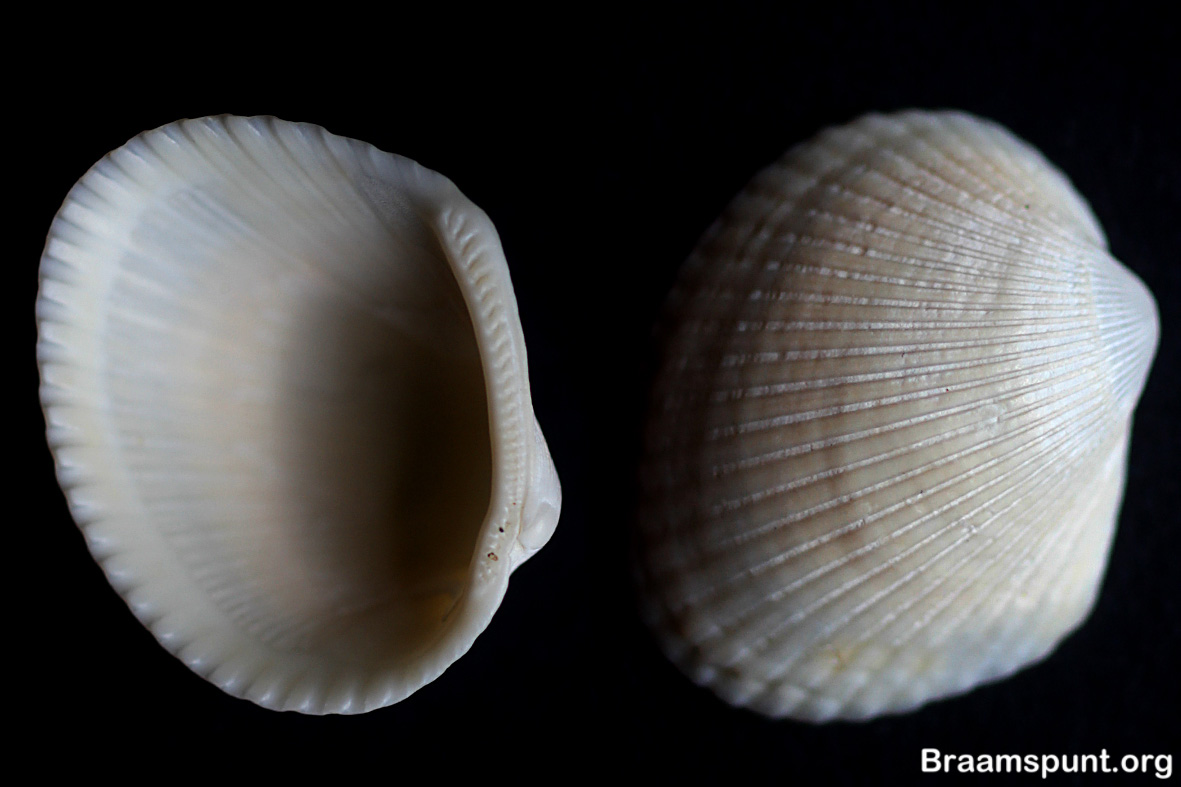 Measuring up to 5.25 cm long, the Anadara ovalis is known to be thick, sturdy, equivalve, inequilateral (beaks anterior to midline) and oval in shape except for a widely splayed out posterior end. The valves on this species are much flatter and the beaks much closer together (almost touching) and more anterior than Scapharca chemnitzii. Its color is white, cream, grey or brown, and is sometimes banded. It has 32-34 broad smooth ribs (of other two species) that are wider than the grooves between them. In large specimens, irregular growth rings can be seen near the margins. The hinge line is more curved than in Scapharca Chemnitzii, and bears some 30-40 teeth, the larger specimens usually having more. A thick hairy or velvety reddish-brown periostracum covers the lower 1/3 of the shell, but may extend up as far as the beaks via the radial grooves between the ribs. It possesses red blood (hence its name) due to the red blood pigment haemoglobin and is one of the very few molluscs to have it; most others possess the colorless pigments haemocyanin and haemerythrin. It is found in relatively shallow water and is fairly common, the live specimens are often found at low tide at the East beach mudflats or are sometimes washed up on the shore.
Measuring up to 5.25 cm long, the Anadara ovalis is known to be thick, sturdy, equivalve, inequilateral (beaks anterior to midline) and oval in shape except for a widely splayed out posterior end. The valves on this species are much flatter and the beaks much closer together (almost touching) and more anterior than Scapharca chemnitzii. Its color is white, cream, grey or brown, and is sometimes banded. It has 32-34 broad smooth ribs (of other two species) that are wider than the grooves between them. In large specimens, irregular growth rings can be seen near the margins. The hinge line is more curved than in Scapharca Chemnitzii, and bears some 30-40 teeth, the larger specimens usually having more. A thick hairy or velvety reddish-brown periostracum covers the lower 1/3 of the shell, but may extend up as far as the beaks via the radial grooves between the ribs. It possesses red blood (hence its name) due to the red blood pigment haemoglobin and is one of the very few molluscs to have it; most others possess the colorless pigments haemocyanin and haemerythrin. It is found in relatively shallow water and is fairly common, the live specimens are often found at low tide at the East beach mudflats or are sometimes washed up on the shore.
Nuculana concentrica (Say, 1824) - Concentric lined nut or Concentric nut clam
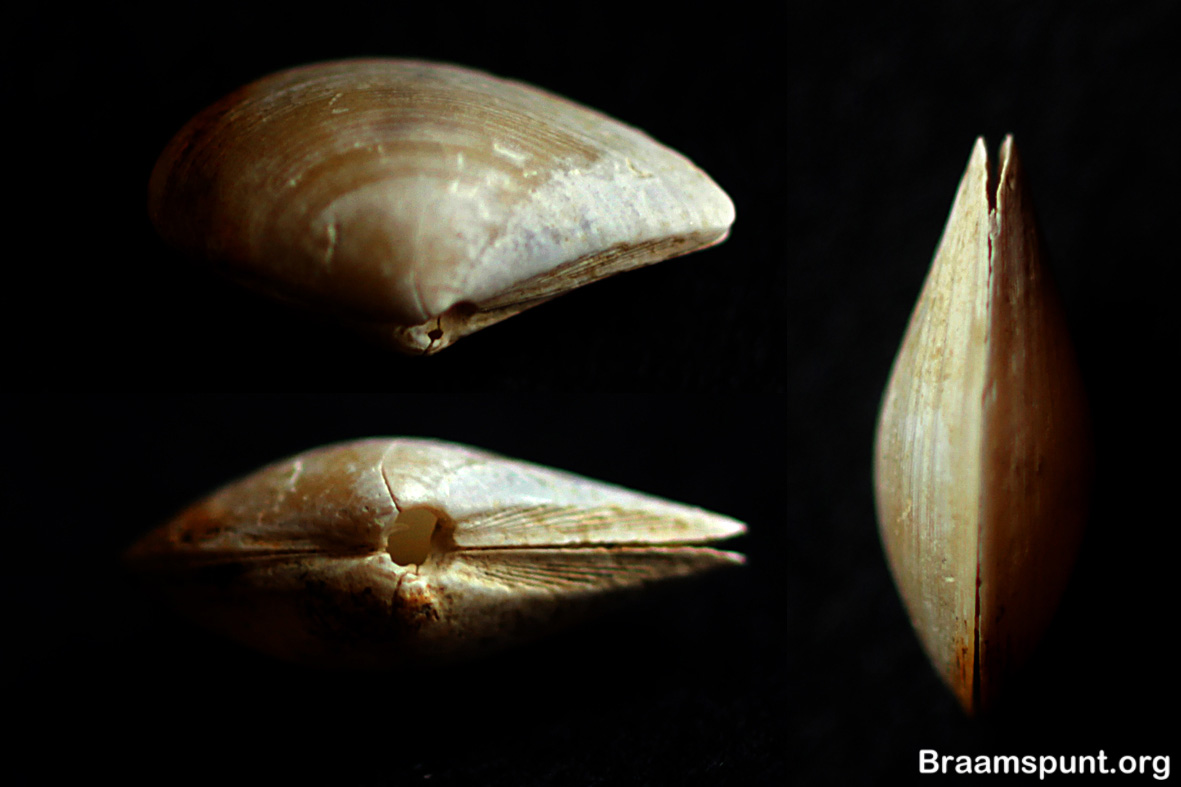 Measuring up to nearly 2 cm long, the Nuculana concentrica is strong, having an inequilateral roundly pointed anterior that tapers posteriorly to a fairly sharp point that turns slightly upwards. It is glossy white, cream, grey-white or grey in color. The interior of shell is usually the same color as the rest of the shell. It is sculptured by very fine and numerous concentric striae, but is nevertheless still quite smooth. The umbones are completely smooth and do not possess this sculpturing. The ligament internal and housed in a chondrophore, and it has 16-20 teeth in both anterior and posterior groups; the teeth are roughly equal in number in both the anterior and posterior groups. The pallial sinus is not easy to see. It is easily distinguished from Adrana scaphoides, A. egregia and A. gloriosa by its small size and from Y. crosbyana by its pointed posterior end. It was once uncommon. All the shell found at Braamspunt were less than 1 cm long and double valves were found.
Measuring up to nearly 2 cm long, the Nuculana concentrica is strong, having an inequilateral roundly pointed anterior that tapers posteriorly to a fairly sharp point that turns slightly upwards. It is glossy white, cream, grey-white or grey in color. The interior of shell is usually the same color as the rest of the shell. It is sculptured by very fine and numerous concentric striae, but is nevertheless still quite smooth. The umbones are completely smooth and do not possess this sculpturing. The ligament internal and housed in a chondrophore, and it has 16-20 teeth in both anterior and posterior groups; the teeth are roughly equal in number in both the anterior and posterior groups. The pallial sinus is not easy to see. It is easily distinguished from Adrana scaphoides, A. egregia and A. gloriosa by its small size and from Y. crosbyana by its pointed posterior end. It was once uncommon. All the shell found at Braamspunt were less than 1 cm long and double valves were found.
Pholas campechiensis (Gmelin,1791) - Wing shell, Campeche angel wing
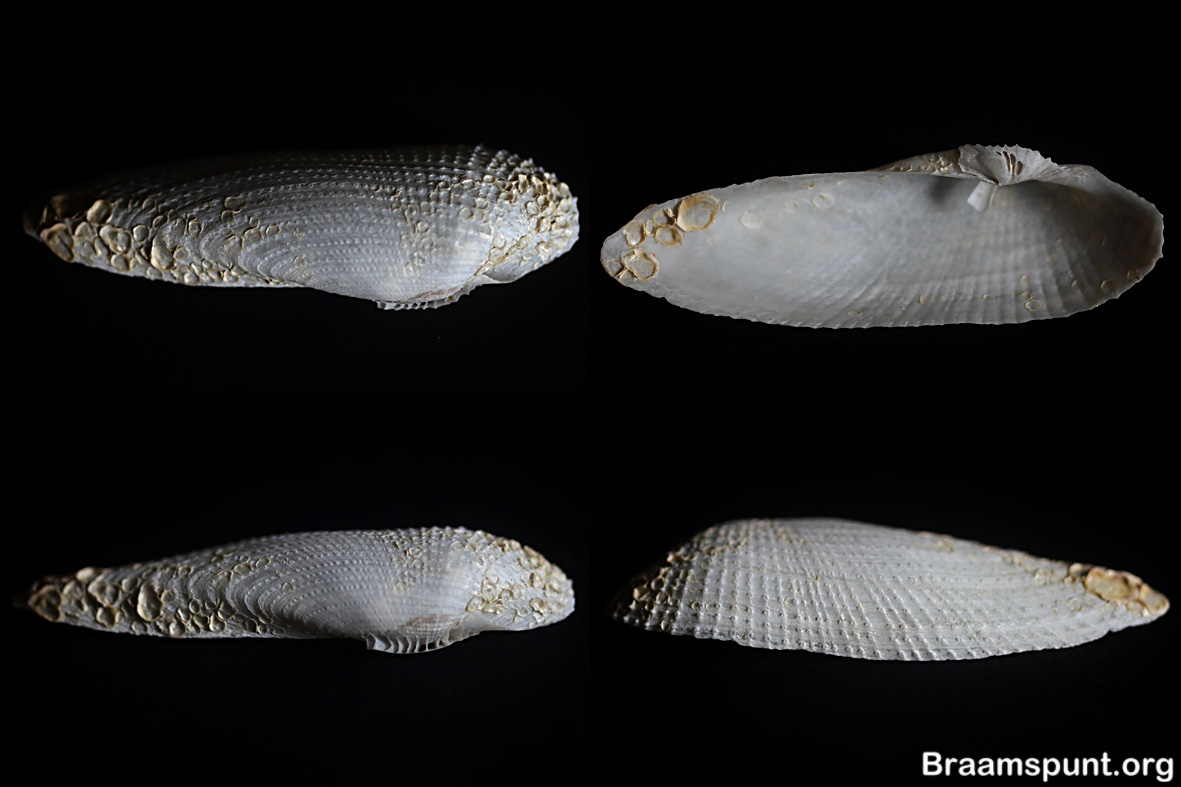 This resembles the Angel Wing but is slightly more pointed anteriorly and much longer and more pointed posteriorly. Up to 12 cm in length. Small specimens tend to be pure white but larger ones vary from white to slate grey. Valves bear 20-40 beaded ribs, smaller specimens having less. At the anterior end these ribs are distinct and the beads sharp and abrasive, but at the posterior end they are indistinct and the beads smooth. There are also concentric growth rings which become very distinct posteriorly. The apophysis is stout and the umbonal reflection is large and septated thus resembling a viaduct. Interior of shell lightly furrowed due to the external ribs. Margins fairly smooth except anteriorly. Pallial sinus does not quite reach the midline. They live in colonies in vertical burrows and in sand close to the shore.
This resembles the Angel Wing but is slightly more pointed anteriorly and much longer and more pointed posteriorly. Up to 12 cm in length. Small specimens tend to be pure white but larger ones vary from white to slate grey. Valves bear 20-40 beaded ribs, smaller specimens having less. At the anterior end these ribs are distinct and the beads sharp and abrasive, but at the posterior end they are indistinct and the beads smooth. There are also concentric growth rings which become very distinct posteriorly. The apophysis is stout and the umbonal reflection is large and septated thus resembling a viaduct. Interior of shell lightly furrowed due to the external ribs. Margins fairly smooth except anteriorly. Pallial sinus does not quite reach the midline. They live in colonies in vertical burrows and in sand close to the shore.
Raeta plicatella (Lamarck , 1818) - Channeled Duck Clam.
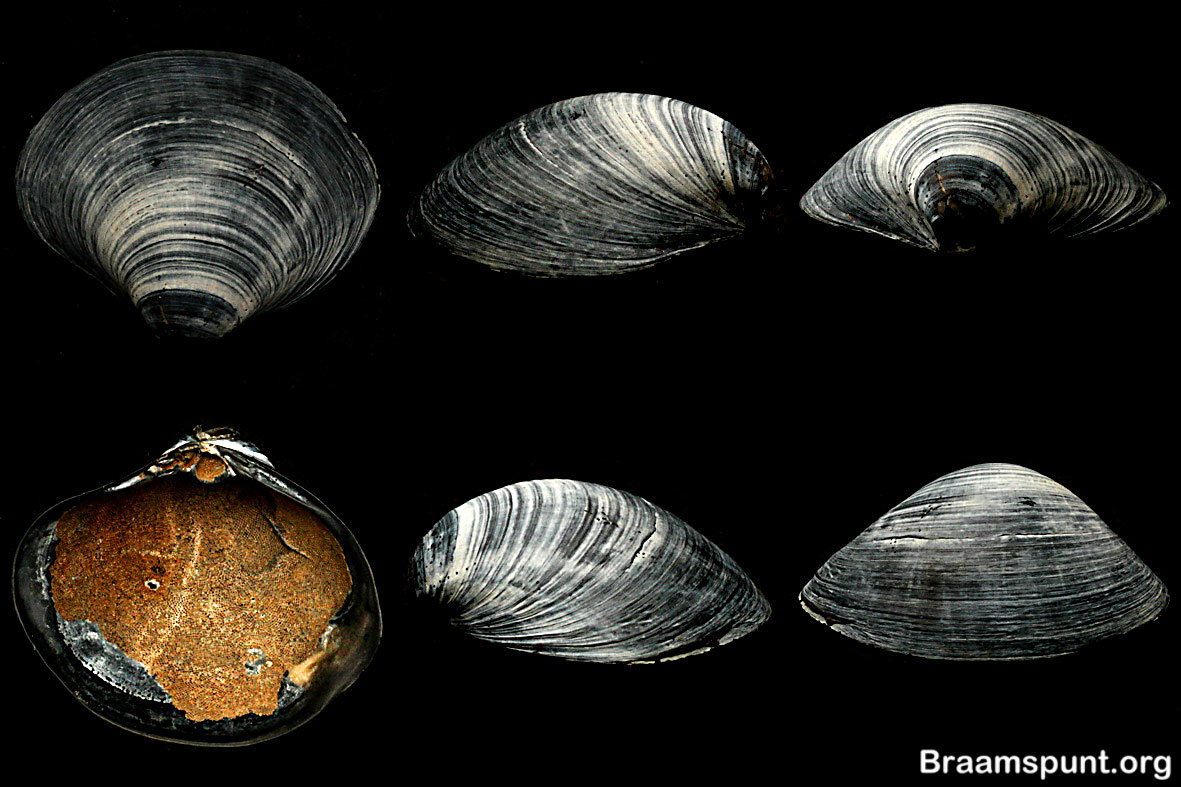 Up to 7.5 cm long, inequilateral (beaks posterior to midline), broad anteriorly but more pointed and gaping posteriorly. White, yellow-brown or grey in color and extremely fragile. The external surface is sculptured by distinct, smooth, concentric ridges and grooves which are more numerous and closer inside of the valves. The left valve bears 3 cardinal teeth ( 2 of which form the characteristic V-shape and the 3rd which is weak and often broken), 1 anterior and 1 posterior lateral. The right valve bears 2 cardinal teeth and 1 posterior lateral tooth but the anterior one appears to be absent. There is again a prominent chondrophore separated from the external ligament by a thin plate or spetum. Pallial sinus fairly well developed. Red-brown periostracum.
Up to 7.5 cm long, inequilateral (beaks posterior to midline), broad anteriorly but more pointed and gaping posteriorly. White, yellow-brown or grey in color and extremely fragile. The external surface is sculptured by distinct, smooth, concentric ridges and grooves which are more numerous and closer inside of the valves. The left valve bears 3 cardinal teeth ( 2 of which form the characteristic V-shape and the 3rd which is weak and often broken), 1 anterior and 1 posterior lateral. The right valve bears 2 cardinal teeth and 1 posterior lateral tooth but the anterior one appears to be absent. There is again a prominent chondrophore separated from the external ligament by a thin plate or spetum. Pallial sinus fairly well developed. Red-brown periostracum.
Petricola pholadiformis gracilis Deshayes
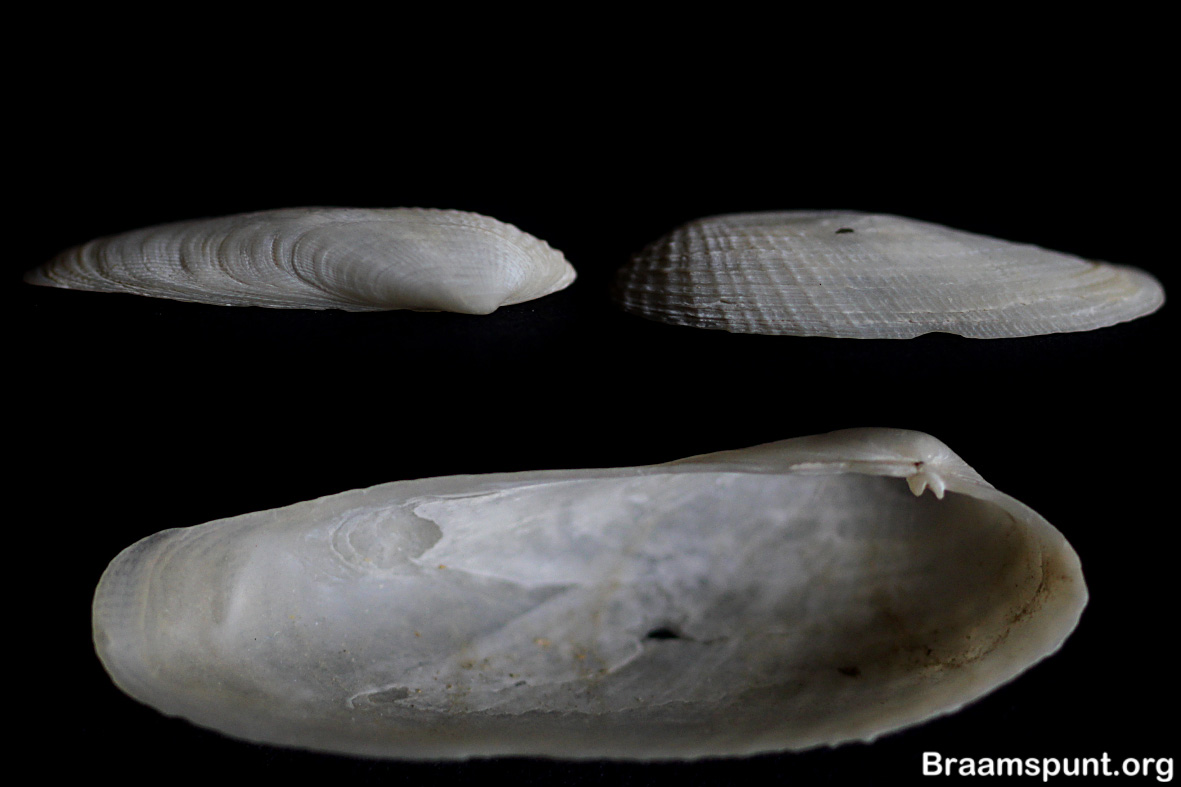 Up to 4 cm long, oval, thin, and the beaks are very anterior. Broader and shorter anteriorly but comes to a sharper point than the narrow, elongated, gaping posterior end. Off-white ( fawn) or white in color with a dark brown periostracum. Sculpture consists of over 40 radial ribs and numerous ( but less obvious fine concentric growth lines. These radial ribs are less numerous anteriorly, but are larger, rougher, more widely spaced and bear sharp spines ( used in boring), the margin thus being crenulated in this region but smooth elsewhere. Posteriorly they become more numerous but fainter and lack the spines. The cardinal teeth are long and pointed there being 2 in the right valve (of which the posterior one is grooved along its length i.e bifid) and 3 in the left valve. The anterior 2 protrude into the mantle cavity ( as in the right valve), but the posterior one is parallel with the hinge line and does not protrude. This posterior tooth may not be very obvious in worn specimens. The median cardinal tooth is bifid. Lunule well defined. The interior of the shell is white but not very smooth as the ribs show through. Bores horizontally and mechanically ( i.e without use of enzymes or acids). Can also be found in salts marshes. It resembles small specimens of Pholas campechiensis ( Pholadidae) but lacks the umbonal reflection ( ‘viaduct’). This specimen is very rare.
Up to 4 cm long, oval, thin, and the beaks are very anterior. Broader and shorter anteriorly but comes to a sharper point than the narrow, elongated, gaping posterior end. Off-white ( fawn) or white in color with a dark brown periostracum. Sculpture consists of over 40 radial ribs and numerous ( but less obvious fine concentric growth lines. These radial ribs are less numerous anteriorly, but are larger, rougher, more widely spaced and bear sharp spines ( used in boring), the margin thus being crenulated in this region but smooth elsewhere. Posteriorly they become more numerous but fainter and lack the spines. The cardinal teeth are long and pointed there being 2 in the right valve (of which the posterior one is grooved along its length i.e bifid) and 3 in the left valve. The anterior 2 protrude into the mantle cavity ( as in the right valve), but the posterior one is parallel with the hinge line and does not protrude. This posterior tooth may not be very obvious in worn specimens. The median cardinal tooth is bifid. Lunule well defined. The interior of the shell is white but not very smooth as the ribs show through. Bores horizontally and mechanically ( i.e without use of enzymes or acids). Can also be found in salts marshes. It resembles small specimens of Pholas campechiensis ( Pholadidae) but lacks the umbonal reflection ( ‘viaduct’). This specimen is very rare.
Mulina cleryana (d’Orbigny) - Puerto Rican Surf Clam
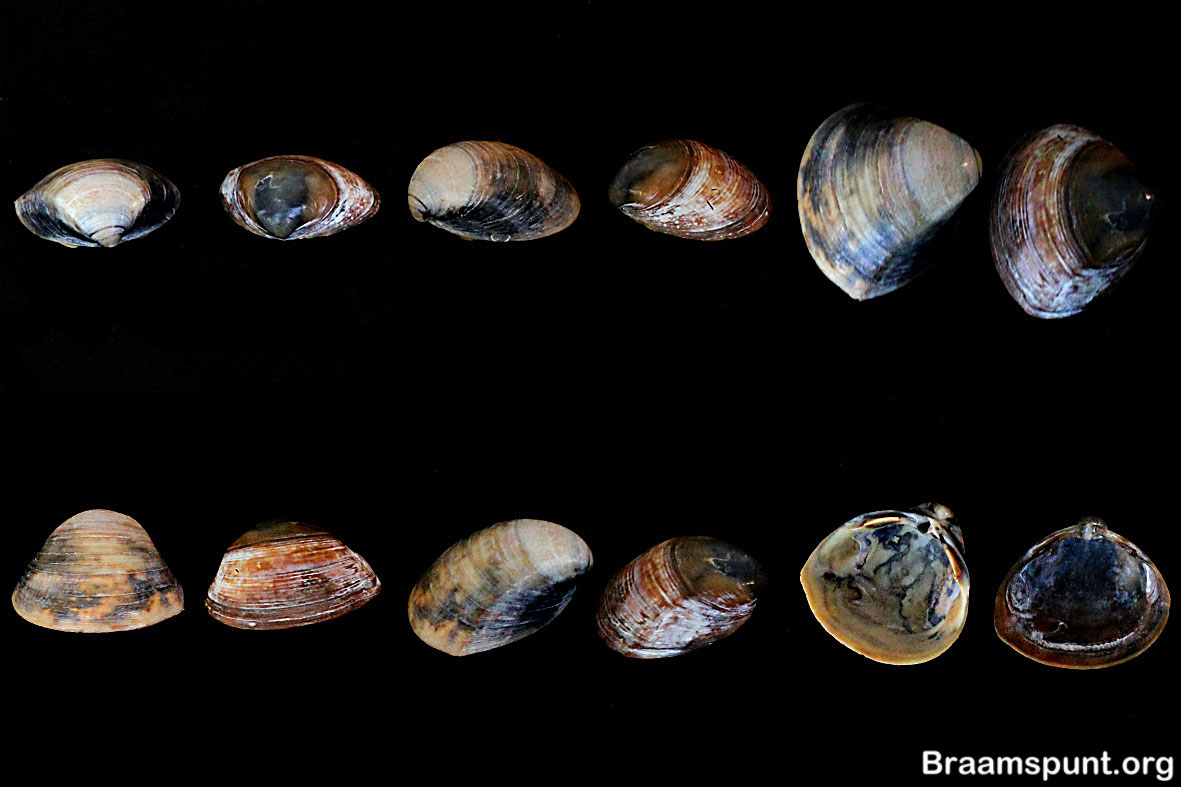 Up to 3.75 cm long, slightly inequilateral ( beaks very slightly anterior to midline). White, cream, light brown or grey in color (or mixtures thereof). The shell is thicker than in Mactrellona iheringi and the umbonal region is higher, each valve thus being more convex. The posterior region bears a distinct radial ridge. The external surface is smooth except for concentric growth rings and the inside is shiny. The right valve bears 2 cardinal teeth, 2 anterior laterals and 2 posterior laterals. The left valve bears 3 cardinals, 1 anterior lateral and 1 posterior lateral. The 2 anterior cardinal teeth form the characteristic V-shape and the 3rd one (which is very weak and often broken) is just behind them. Again there is a prominent chondrophore. The pallial sinus is not as well developed as in Mactrellona iheringi and fails to reach the midline. The periostracum is brown and fairly thick. This species is very common.
Up to 3.75 cm long, slightly inequilateral ( beaks very slightly anterior to midline). White, cream, light brown or grey in color (or mixtures thereof). The shell is thicker than in Mactrellona iheringi and the umbonal region is higher, each valve thus being more convex. The posterior region bears a distinct radial ridge. The external surface is smooth except for concentric growth rings and the inside is shiny. The right valve bears 2 cardinal teeth, 2 anterior laterals and 2 posterior laterals. The left valve bears 3 cardinals, 1 anterior lateral and 1 posterior lateral. The 2 anterior cardinal teeth form the characteristic V-shape and the 3rd one (which is very weak and often broken) is just behind them. Again there is a prominent chondrophore. The pallial sinus is not as well developed as in Mactrellona iheringi and fails to reach the midline. The periostracum is brown and fairly thick. This species is very common.
Donax striatus (Linnaeus, 1767) – Striate Donax
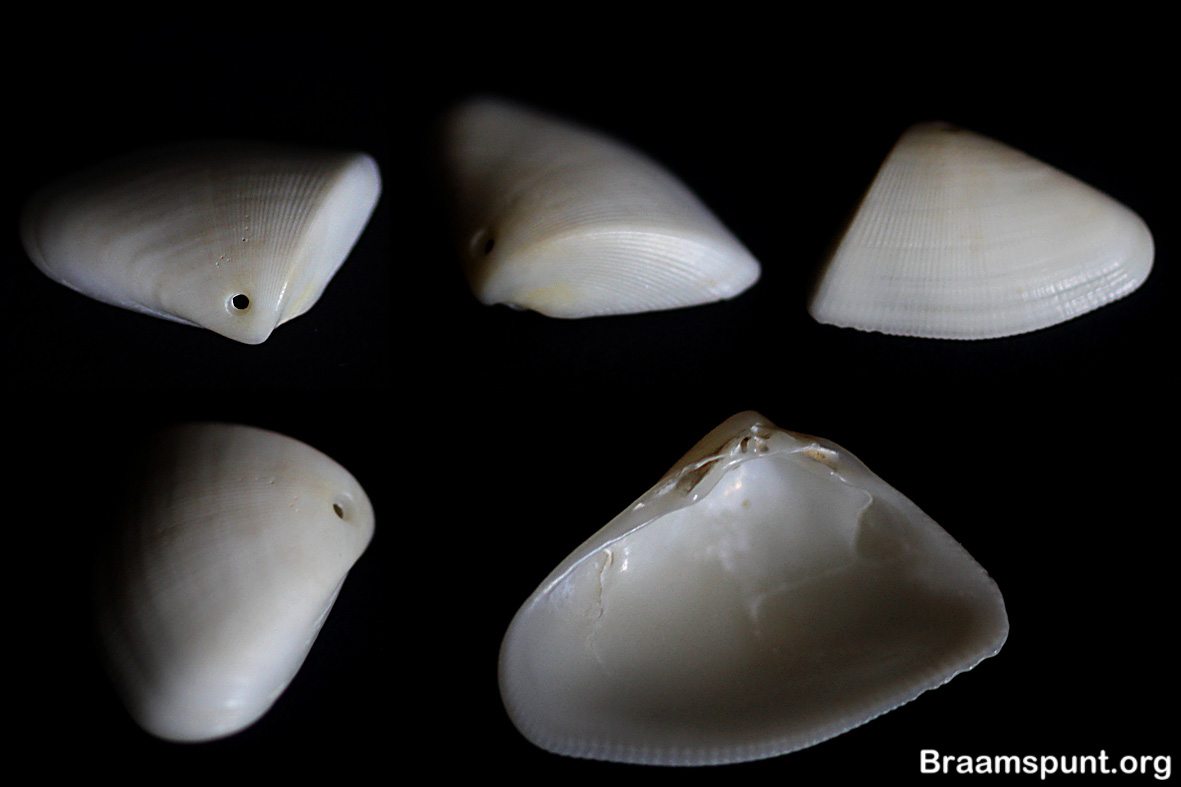 Donax striatus is very similar in size and shape to the Donax denticulatus but has only a single ridge on the posterior slope and the pallial sinus is not as deep, only reaching as far as the beaks. The color is also more uniform-usually white but often with black or brown streaks or blotches. Concentric rings may be present but are not distinct as in the last species. There is a single anterior lateral tooth in the right valve, otherwise the teeth are the same as in D. denticulatus. The inner margin is again toothed or crenulated. This species is also very common.
Donax striatus is very similar in size and shape to the Donax denticulatus but has only a single ridge on the posterior slope and the pallial sinus is not as deep, only reaching as far as the beaks. The color is also more uniform-usually white but often with black or brown streaks or blotches. Concentric rings may be present but are not distinct as in the last species. There is a single anterior lateral tooth in the right valve, otherwise the teeth are the same as in D. denticulatus. The inner margin is again toothed or crenulated. This species is also very common.
